-
 The Lysistrata of Aristophanes | Wholly translated into English and illustrated with eight full-page drawings by Aubrey Beardsley with a preface on Aristophanic Comedy and its reflection in the art of the Illustrator by George Frederic Lees, Aristophanes, illus. by Aubrey Beardsley, forward by George Frederic Lees (Privately Printed in Paris, 1931, #352/525) 11.25" X 9.25", 61pp, loosely bound with loose cover, with original slip-case, printed on hand-made Van Gelder paper, 8 illustrations printed on mould-made Annoy Paper, interior pages clean and in fine condition, slip-case is in poor condition, some soiling on the cover. Aristophanes was the greatest writer of ancient Athenian “old comedy,” known for its satires of contemporary life and for its broad, often obscene humor. Lysistrata was first produced in 411 BC, when the Peloponnesian War had been devastating Greece for 20 years. Most people know the plot: Lysistrata assembles women from all of Greece, and they agree that they will not have sex until the men make peace. Aubrey Beardsley was the greatest and the most controversial Art Nouveau illustrator in England, famous for his illustrations of Mallory’s Morte d’Arthur, Oscar Wilde’s Salome, Pope’s The Rape of the Lock, and for several magazines. Because he was associated with Oscar Wilde, Beardsley lost his job as art editor of a magazine named The Yellow Book in 1895, soon after Wilde was arrested for homosexuality. He was approached by Leonard Smithers, a publisher of erotic books, who asked him to illustrate Lysistrata. His illustrations are very much in the spirit of Aristophanes, as funny as they are obscene. Beardsley converted to Catholicism in 1897, and soon after, he asked Smithers to “destroy all copies of Lysistrata” with its “obscene drawings,” but Smithers refused. Beardsley died of tuberculosis in 1898, at the age of 26. Smithers initially published Lysistrata in a limited edition of one hundred copies. It was occasionally reprinted in very small runs, usually clandestinely, often poorly, but copies have long been scarce and expensive. I have only found this copy a few places outside of museums and libraries. This is a rare fine reproduction of the original drawings on quality paper. I do not have information about the actual publisher.
The Lysistrata of Aristophanes | Wholly translated into English and illustrated with eight full-page drawings by Aubrey Beardsley with a preface on Aristophanic Comedy and its reflection in the art of the Illustrator by George Frederic Lees, Aristophanes, illus. by Aubrey Beardsley, forward by George Frederic Lees (Privately Printed in Paris, 1931, #352/525) 11.25" X 9.25", 61pp, loosely bound with loose cover, with original slip-case, printed on hand-made Van Gelder paper, 8 illustrations printed on mould-made Annoy Paper, interior pages clean and in fine condition, slip-case is in poor condition, some soiling on the cover. Aristophanes was the greatest writer of ancient Athenian “old comedy,” known for its satires of contemporary life and for its broad, often obscene humor. Lysistrata was first produced in 411 BC, when the Peloponnesian War had been devastating Greece for 20 years. Most people know the plot: Lysistrata assembles women from all of Greece, and they agree that they will not have sex until the men make peace. Aubrey Beardsley was the greatest and the most controversial Art Nouveau illustrator in England, famous for his illustrations of Mallory’s Morte d’Arthur, Oscar Wilde’s Salome, Pope’s The Rape of the Lock, and for several magazines. Because he was associated with Oscar Wilde, Beardsley lost his job as art editor of a magazine named The Yellow Book in 1895, soon after Wilde was arrested for homosexuality. He was approached by Leonard Smithers, a publisher of erotic books, who asked him to illustrate Lysistrata. His illustrations are very much in the spirit of Aristophanes, as funny as they are obscene. Beardsley converted to Catholicism in 1897, and soon after, he asked Smithers to “destroy all copies of Lysistrata” with its “obscene drawings,” but Smithers refused. Beardsley died of tuberculosis in 1898, at the age of 26. Smithers initially published Lysistrata in a limited edition of one hundred copies. It was occasionally reprinted in very small runs, usually clandestinely, often poorly, but copies have long been scarce and expensive. I have only found this copy a few places outside of museums and libraries. This is a rare fine reproduction of the original drawings on quality paper. I do not have information about the actual publisher. -
 Aristophanes: Lysistrata, Aristophanes, illus. by Aubrey Beardsley (Beardsley Press, 1927, one of 750 unnumbered) 8.25″ x 11.5″, 99pp, quarter silver over black cloth, with silver and black patterned endpapers, black lettering to spine, good condition for age, bumping and scraping present, Beardsley’s prints are tipped in. Aristophanes was the greatest writer of ancient Athenian “old comedy,” known for its satires of contemporary life and for its broad, often obscene humor. Lysistrata was first produced in 411 BC, when the Peloponnesian War had been devastating Greece for 20 years. Most people know the plot: Lysistrata assembles women from all of Greece, and they agree that they will not have sex until the men make peace. Aubrey Beardsley was the greatest and the most controversial Art Nouveau illustrator in England, famous for his illustrations of Mallory’s Morte d’Arthur, Oscar Wilde’s Salome, Pope’s The Rape of the Lock, and for several magazines. Because he was associated with Oscar Wilde, Beardsley lost his job as art editor of a magazine named The Yellow Book in 1895, soon after Wilde was arrested for homosexuality. He was approached by Leonard Smithers, a publisher of erotic books, who asked him to illustrate Lysistrata. His illustrations are very much in the spirit of Aristophanes, as funny as they are obscene. Beardsley converted to Catholicism in 1897, and soon after, he asked Smithers to “destroy all copies of Lysistrata” with its “obscene drawings,” but Smithers refused. Beardsley died of tuberculosis in 1898, at the age of 26. Smithers initially published Lysistrata in a limited edition of one hundred copies. It was occasionally reprinted in very small runs, usually clandestinely, often poorly, but copies have long been scarce and expensive. Few copies of Beardsley’s Lysistrata printed before 1966 are currently in circulation. This copy is a rare limited edition printed by the Beardsley Press, London and even rarer with the binding intact.
Aristophanes: Lysistrata, Aristophanes, illus. by Aubrey Beardsley (Beardsley Press, 1927, one of 750 unnumbered) 8.25″ x 11.5″, 99pp, quarter silver over black cloth, with silver and black patterned endpapers, black lettering to spine, good condition for age, bumping and scraping present, Beardsley’s prints are tipped in. Aristophanes was the greatest writer of ancient Athenian “old comedy,” known for its satires of contemporary life and for its broad, often obscene humor. Lysistrata was first produced in 411 BC, when the Peloponnesian War had been devastating Greece for 20 years. Most people know the plot: Lysistrata assembles women from all of Greece, and they agree that they will not have sex until the men make peace. Aubrey Beardsley was the greatest and the most controversial Art Nouveau illustrator in England, famous for his illustrations of Mallory’s Morte d’Arthur, Oscar Wilde’s Salome, Pope’s The Rape of the Lock, and for several magazines. Because he was associated with Oscar Wilde, Beardsley lost his job as art editor of a magazine named The Yellow Book in 1895, soon after Wilde was arrested for homosexuality. He was approached by Leonard Smithers, a publisher of erotic books, who asked him to illustrate Lysistrata. His illustrations are very much in the spirit of Aristophanes, as funny as they are obscene. Beardsley converted to Catholicism in 1897, and soon after, he asked Smithers to “destroy all copies of Lysistrata” with its “obscene drawings,” but Smithers refused. Beardsley died of tuberculosis in 1898, at the age of 26. Smithers initially published Lysistrata in a limited edition of one hundred copies. It was occasionally reprinted in very small runs, usually clandestinely, often poorly, but copies have long been scarce and expensive. Few copies of Beardsley’s Lysistrata printed before 1966 are currently in circulation. This copy is a rare limited edition printed by the Beardsley Press, London and even rarer with the binding intact. -
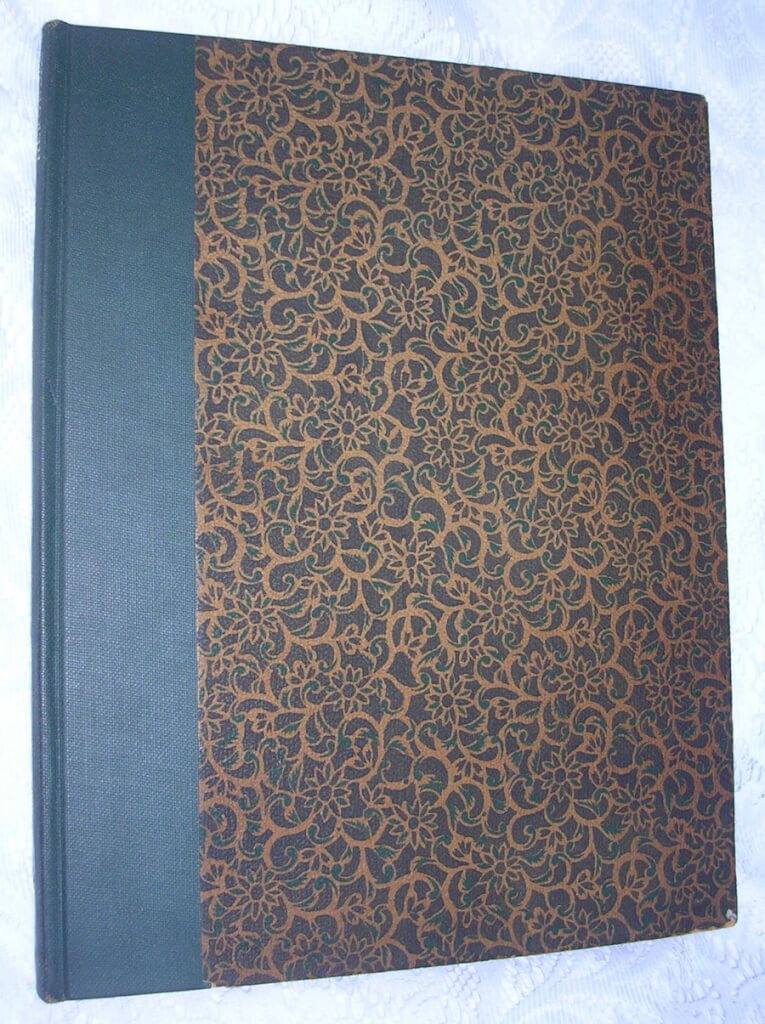
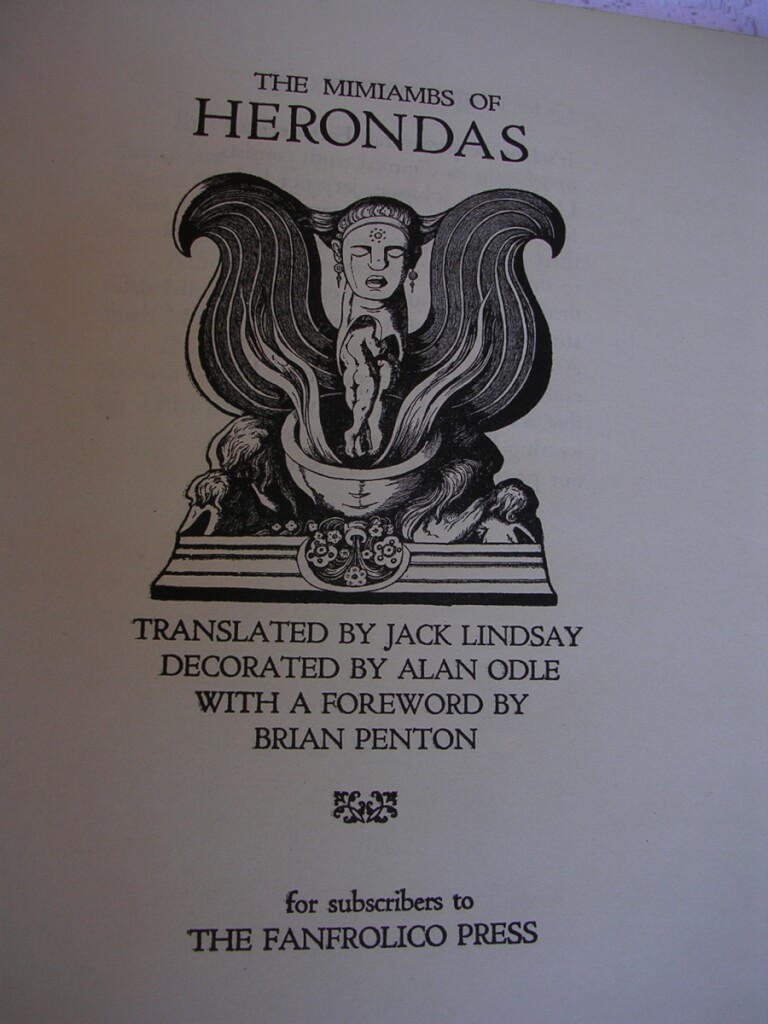 The Mimiambs of Herondas, Herodas, Translated by Jack Lindsay, Decorated by Alan Odle, with a Foreword by Brian Penton. (The Fanfrolico Press, London, nd [c. 1929], #106/375 [first edition, and first Fanfrolico to be printed in London]) 11 7/8" X 9 3/8", unpaginated 72pp, hardbound no DJ, original buckram-backed decorated Japanese paper boards with plain green cloth spine and gilt lettering, top edge gilt, other edges deckle, very good condition minor wear to bottom of boards, Cloister types on Van Gelder Antique handmade paper Herodas was a Greek poet and the author of short humorous dramatic scenes in verse, written under the Alexandrian empire in the 3rd century BC. Mimes were scenes in popular life in South Italy and Sicily, written in the language of the people, vigorous with racy proverbs such as we get in other reflections of that region. The Mimes of Herodas have been known to us only since the discovery and publication of the "Kenyon", M. S. Buck, by the British Museum in 1891 (from a parchment containing 7 legible mimes half of the 8th and a fragment of the 9th). This was Fanfrolico's first London book. It was published "for subscribers to The Franfrolico Press". This new translation of Mimiambs of Herondas was translated by Jack Lindsay and beautifully illustrated by Alan Odle whose grotesque and subversive style was a precursor of surrealism. This is a beautiful printed book in great condition and quite rare. Fanfrolico Press, Australia’s first ‘private press’ in the arts-and-craft tradition, was founded by Jack Lindsay, P. R. Stephensen and John Kirtley, originally in North Sydney in 1923. The press specialized in printings artful, limited editions of classics and forgotten works that were suited to the extravagant style of artist like his father, artist, sculptor and author Norman Lindsay who illustrated many of their books. Fanfrolico was scornful of modernism and with its florid style determinedly backward-looking. They did surprisingly well, despite the lack of business expertise of their young, ambitious "bohemian" owners, eking out a living despite the risky move to London in 1926 and upheavals in ownership that saw the departure in 1927 of Kirtley, and then Stephenson in 1929. Sometime in 1930 they published their last book.
The Mimiambs of Herondas, Herodas, Translated by Jack Lindsay, Decorated by Alan Odle, with a Foreword by Brian Penton. (The Fanfrolico Press, London, nd [c. 1929], #106/375 [first edition, and first Fanfrolico to be printed in London]) 11 7/8" X 9 3/8", unpaginated 72pp, hardbound no DJ, original buckram-backed decorated Japanese paper boards with plain green cloth spine and gilt lettering, top edge gilt, other edges deckle, very good condition minor wear to bottom of boards, Cloister types on Van Gelder Antique handmade paper Herodas was a Greek poet and the author of short humorous dramatic scenes in verse, written under the Alexandrian empire in the 3rd century BC. Mimes were scenes in popular life in South Italy and Sicily, written in the language of the people, vigorous with racy proverbs such as we get in other reflections of that region. The Mimes of Herodas have been known to us only since the discovery and publication of the "Kenyon", M. S. Buck, by the British Museum in 1891 (from a parchment containing 7 legible mimes half of the 8th and a fragment of the 9th). This was Fanfrolico's first London book. It was published "for subscribers to The Franfrolico Press". This new translation of Mimiambs of Herondas was translated by Jack Lindsay and beautifully illustrated by Alan Odle whose grotesque and subversive style was a precursor of surrealism. This is a beautiful printed book in great condition and quite rare. Fanfrolico Press, Australia’s first ‘private press’ in the arts-and-craft tradition, was founded by Jack Lindsay, P. R. Stephensen and John Kirtley, originally in North Sydney in 1923. The press specialized in printings artful, limited editions of classics and forgotten works that were suited to the extravagant style of artist like his father, artist, sculptor and author Norman Lindsay who illustrated many of their books. Fanfrolico was scornful of modernism and with its florid style determinedly backward-looking. They did surprisingly well, despite the lack of business expertise of their young, ambitious "bohemian" owners, eking out a living despite the risky move to London in 1926 and upheavals in ownership that saw the departure in 1927 of Kirtley, and then Stephenson in 1929. Sometime in 1930 they published their last book. -
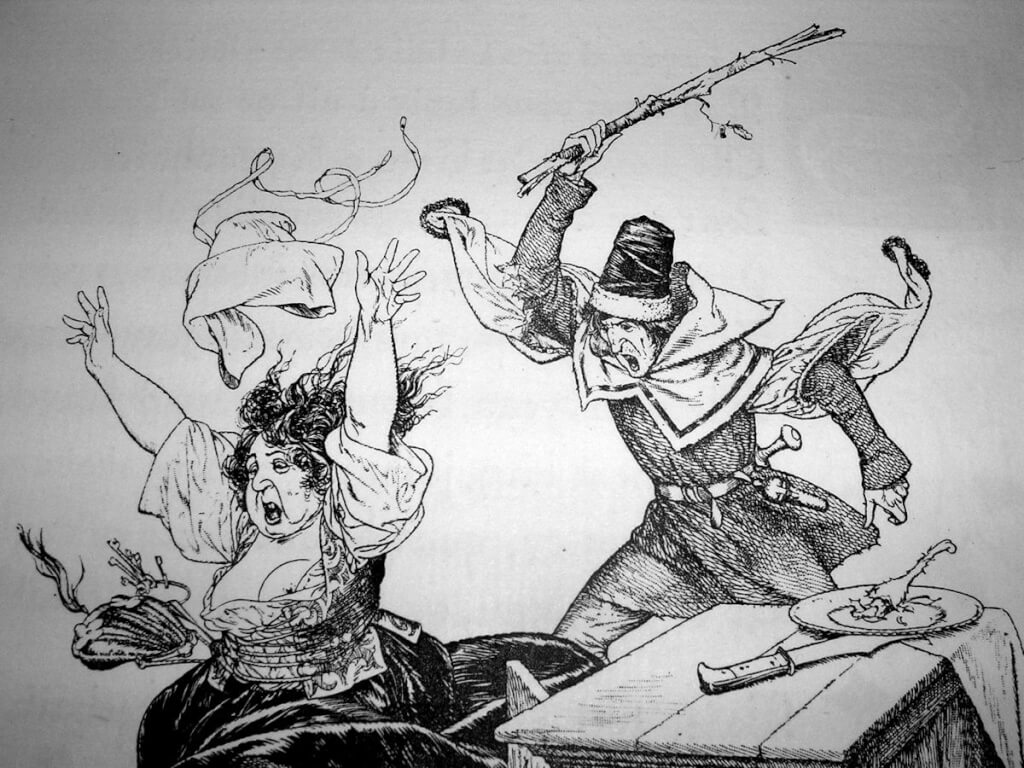
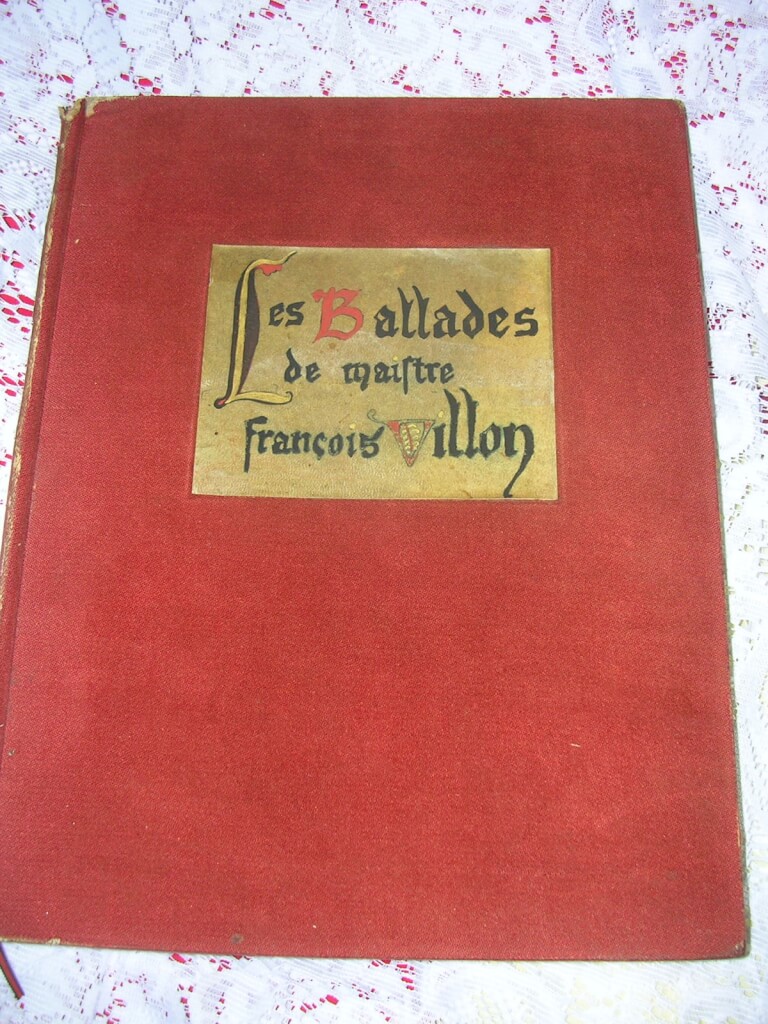 Les Ballades de Maistre Francois Villon, Francois Villon, illus. Chéri Hérouard, caligraphy ["escrites"] by Raymond de Rigné (chez Cres., Paris, 1919) 11.75" X 9.25", 169pp, rebound in red cloth boards with paper labels, decorated end papers. Original soft wraps intact. #450/550 signed by Hérouard. 31 full page drawings by Hérouard plus 31 small vignette type illustrations with a few "signed" by him. Beautifully printed on heavy deckle edged paper. good condition, wear to top and bottom of spine. ribbon intact. François Villon (c. 1431_1464) was a French poet. Most of what is known about Villon has been gathered from legal records and gleaned from his own writings. He was a thief, killer, barroom brawler, and vagabond. He is perhaps best known for his Testaments and his Ballades. He was the most famous realist poet of the Middle Ages. Chéri Hérouard (1881 - 1961) was a French illustrator who was most famously known for his forty-five-year work for French society magazine, La Vie Parisienne. Under the pseudonym of Herric, he also created erotic and sadomasochistic illustrations for various books including the Kama Sutra. This work was originally published with soft wraps. This copy has been beautifully rebound with it's original wraps intact.
Les Ballades de Maistre Francois Villon, Francois Villon, illus. Chéri Hérouard, caligraphy ["escrites"] by Raymond de Rigné (chez Cres., Paris, 1919) 11.75" X 9.25", 169pp, rebound in red cloth boards with paper labels, decorated end papers. Original soft wraps intact. #450/550 signed by Hérouard. 31 full page drawings by Hérouard plus 31 small vignette type illustrations with a few "signed" by him. Beautifully printed on heavy deckle edged paper. good condition, wear to top and bottom of spine. ribbon intact. François Villon (c. 1431_1464) was a French poet. Most of what is known about Villon has been gathered from legal records and gleaned from his own writings. He was a thief, killer, barroom brawler, and vagabond. He is perhaps best known for his Testaments and his Ballades. He was the most famous realist poet of the Middle Ages. Chéri Hérouard (1881 - 1961) was a French illustrator who was most famously known for his forty-five-year work for French society magazine, La Vie Parisienne. Under the pseudonym of Herric, he also created erotic and sadomasochistic illustrations for various books including the Kama Sutra. This work was originally published with soft wraps. This copy has been beautifully rebound with it's original wraps intact. -

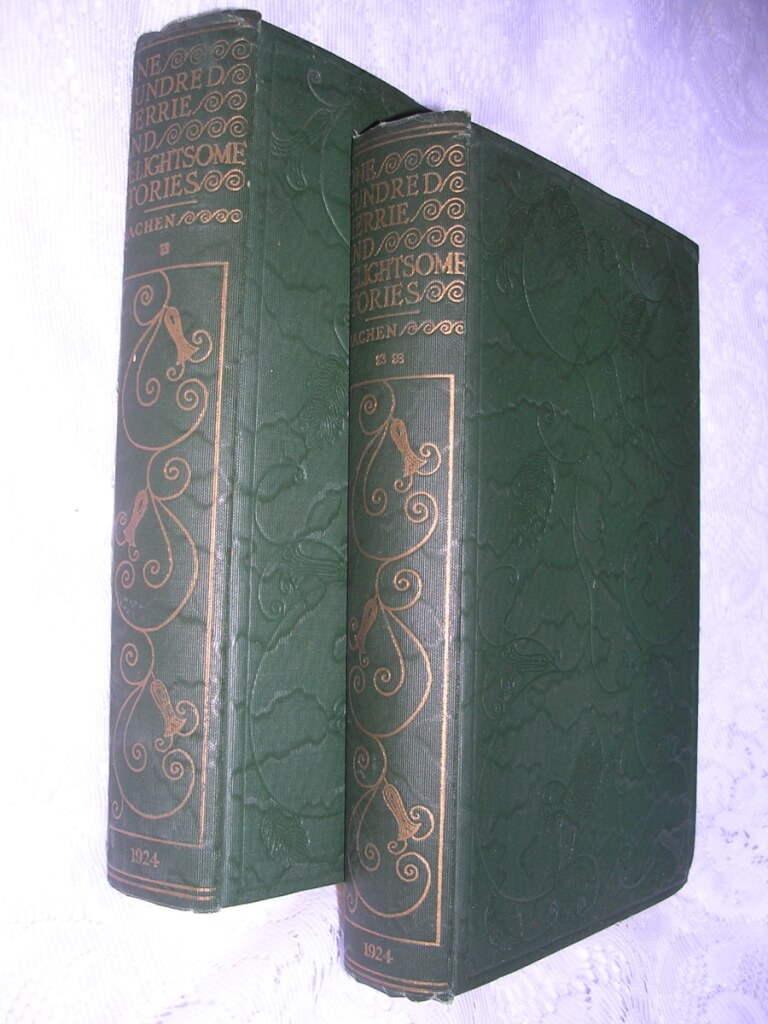 One Hundred Merrie and Delightsome Stories (Les Cent Nouvelles Nouvelles) (2 volumes), trans. Robert B. Douglas (Privately Printed for Subscribers only, Carbonnek, 1924, #591/1250) 8 7/8" X 5 3/4", 2 vol. 279pp 272pp, hardbound no DJ, dark green moire silk boards decorated in blind stamp, spines lettered and decorated in gilt, gilt top edge, other edges deckle, frontispiece signed by the artist, Clara Tice, very good condition, slight bumping on corners This is a two volume set of books beautifully bound and in excellent condition. Some pages remain uncut. A rare book in rare condition. It is signed by the artist, Clara Tice, under the frontispiece. It is illustrated with 16 full page drawings by Clara Tice. Purported a collection of short stories narrated by various persons at the court of Philippe le Bon, and collected together by Antoine de la Sale, the nouvelles are, according to the authority on French Literature—Professor George Saintsbury "undoubtedly the first work of literary prose in French ... The short prose tale of a comic character is the one French literary product the pre-eminence and perfection of which it is impossible to dispute, and the prose tale first appears to advantage in the Cent Nouvelles Nouvelles." The stories give a curious glimpses of life in the 15th century, providing a genuine view of the social condition of the nobility and the middle classes. M. Lenient, a French critic, says: "Generally the incidents and personages belong to the bourgeoisée; there is nothing chivalric, nothing wonderful; no dreamy lovers, romantic dames, fairies, or enchanters. Noble dames, bourgeois, nuns, knights, merchants, monks, and peasants mutually dupe each other. The lord deceives the miller's wife by imposing on her simplicity, and the miller retaliates in much the same manner. The shepherd marries the knight's sister, and the nobleman is not over scandalized. The vices of the monks are depicted in half a score tales, and the seducers are punished with a severity not always in proportion to the offence." For four centuries 10 of the stories were credited to Louis XI. Modern scholars have since ascribed them to either Philippe le Bel or Comte de Charolais. In all, some thirty-two noblemen or squires contributed the stories, with some 14 or 15 taken from Giovanni Boccaccio, and as many more from Gian Francesco Poggio Bracciolini or other Italian writers, or French fabliaux, but about 70 of them appear to be original.
One Hundred Merrie and Delightsome Stories (Les Cent Nouvelles Nouvelles) (2 volumes), trans. Robert B. Douglas (Privately Printed for Subscribers only, Carbonnek, 1924, #591/1250) 8 7/8" X 5 3/4", 2 vol. 279pp 272pp, hardbound no DJ, dark green moire silk boards decorated in blind stamp, spines lettered and decorated in gilt, gilt top edge, other edges deckle, frontispiece signed by the artist, Clara Tice, very good condition, slight bumping on corners This is a two volume set of books beautifully bound and in excellent condition. Some pages remain uncut. A rare book in rare condition. It is signed by the artist, Clara Tice, under the frontispiece. It is illustrated with 16 full page drawings by Clara Tice. Purported a collection of short stories narrated by various persons at the court of Philippe le Bon, and collected together by Antoine de la Sale, the nouvelles are, according to the authority on French Literature—Professor George Saintsbury "undoubtedly the first work of literary prose in French ... The short prose tale of a comic character is the one French literary product the pre-eminence and perfection of which it is impossible to dispute, and the prose tale first appears to advantage in the Cent Nouvelles Nouvelles." The stories give a curious glimpses of life in the 15th century, providing a genuine view of the social condition of the nobility and the middle classes. M. Lenient, a French critic, says: "Generally the incidents and personages belong to the bourgeoisée; there is nothing chivalric, nothing wonderful; no dreamy lovers, romantic dames, fairies, or enchanters. Noble dames, bourgeois, nuns, knights, merchants, monks, and peasants mutually dupe each other. The lord deceives the miller's wife by imposing on her simplicity, and the miller retaliates in much the same manner. The shepherd marries the knight's sister, and the nobleman is not over scandalized. The vices of the monks are depicted in half a score tales, and the seducers are punished with a severity not always in proportion to the offence." For four centuries 10 of the stories were credited to Louis XI. Modern scholars have since ascribed them to either Philippe le Bel or Comte de Charolais. In all, some thirty-two noblemen or squires contributed the stories, with some 14 or 15 taken from Giovanni Boccaccio, and as many more from Gian Francesco Poggio Bracciolini or other Italian writers, or French fabliaux, but about 70 of them appear to be original. -
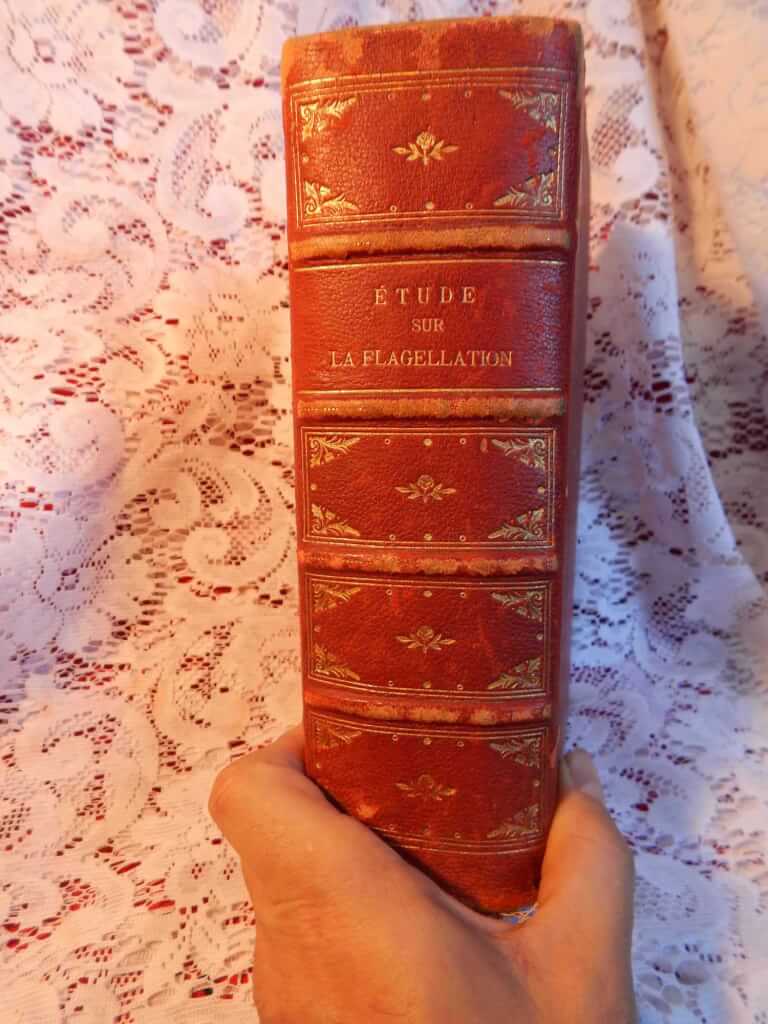
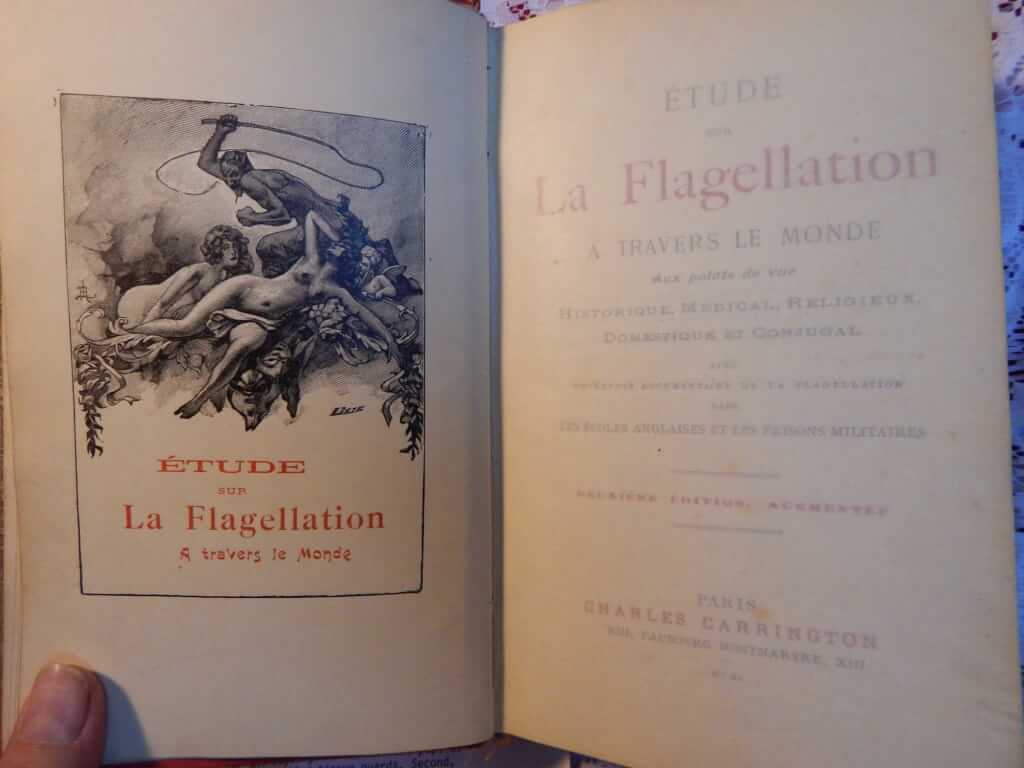 Étude sur La Flagellation a travers le monde aux points de vue Historique, Medical, Religieux, Domestique et Conjugal | avec un exposé documentaire de la flagellation dans Les écoles anglaises et les prisons militaires, Deuxiéme Édition, Augmentée [Study of the Flagellation throughout the world from the historical, medical, religious, domestic and marital points of view | with a documentary presentation of flogging in English Schools and Military Prisons, Second Edition, Augmented], by Jean de Villiot [pseud. most likely of Charles Carrington, Hugues Rebell and Hector France],illust. by René Lelong, (Charles Carrington, Paris, 1901, "Second Edition Augmented", printed by Achevé d'imprimer le 29 septembre 1900 par Em. Pivoteau. Imprimeur à Saint-Amand-Mont-Rond (Cher)) 5.5"x8.5", xxiv+646pp, quarter-bound in red morocco over red boards, 4 raised bands, gilt titles and decorations on spine, marbled paste-downs, all edges gilt, ribbon intact, binding frayed a bit at bottom, some rubbing and stains, otherwise very good condition for age, frontispiece and 20 B&W illustrations by René Lelong tipped in with titled tissue guards. This book is the compilation and expansion of a few other books previously published by Charles Carrington including the original Étude sur La Flagellation a travers le monde published in 1898. It represents a more complete representation of those writings beautifully bound into one book, covering studies on flogging through the centuries, flogging in England, flogging in the history of France (the cases of Madame Du Barry, the Marquise de Rosen.), the flogging from the medical point of view where one learns its healing properties, flogging in literature or the art of using it for pleasure, the discipline to school and domestic and spousal corrections, and "in our current society". Jean de Villiot is a pseudonym frequently used by Carrington and the various authors he relied upon, especially for works that involved flagellation. The illustrator, René Lelong was a third class medalist at the Salon des artistes français of 1895 which he became a member from 1898. He has produced advertising posters and illustrated numerous books and texts. He was a professor at the Julian Academy from 1879 to 1891.
Étude sur La Flagellation a travers le monde aux points de vue Historique, Medical, Religieux, Domestique et Conjugal | avec un exposé documentaire de la flagellation dans Les écoles anglaises et les prisons militaires, Deuxiéme Édition, Augmentée [Study of the Flagellation throughout the world from the historical, medical, religious, domestic and marital points of view | with a documentary presentation of flogging in English Schools and Military Prisons, Second Edition, Augmented], by Jean de Villiot [pseud. most likely of Charles Carrington, Hugues Rebell and Hector France],illust. by René Lelong, (Charles Carrington, Paris, 1901, "Second Edition Augmented", printed by Achevé d'imprimer le 29 septembre 1900 par Em. Pivoteau. Imprimeur à Saint-Amand-Mont-Rond (Cher)) 5.5"x8.5", xxiv+646pp, quarter-bound in red morocco over red boards, 4 raised bands, gilt titles and decorations on spine, marbled paste-downs, all edges gilt, ribbon intact, binding frayed a bit at bottom, some rubbing and stains, otherwise very good condition for age, frontispiece and 20 B&W illustrations by René Lelong tipped in with titled tissue guards. This book is the compilation and expansion of a few other books previously published by Charles Carrington including the original Étude sur La Flagellation a travers le monde published in 1898. It represents a more complete representation of those writings beautifully bound into one book, covering studies on flogging through the centuries, flogging in England, flogging in the history of France (the cases of Madame Du Barry, the Marquise de Rosen.), the flogging from the medical point of view where one learns its healing properties, flogging in literature or the art of using it for pleasure, the discipline to school and domestic and spousal corrections, and "in our current society". Jean de Villiot is a pseudonym frequently used by Carrington and the various authors he relied upon, especially for works that involved flagellation. The illustrator, René Lelong was a third class medalist at the Salon des artistes français of 1895 which he became a member from 1898. He has produced advertising posters and illustrated numerous books and texts. He was a professor at the Julian Academy from 1879 to 1891. -
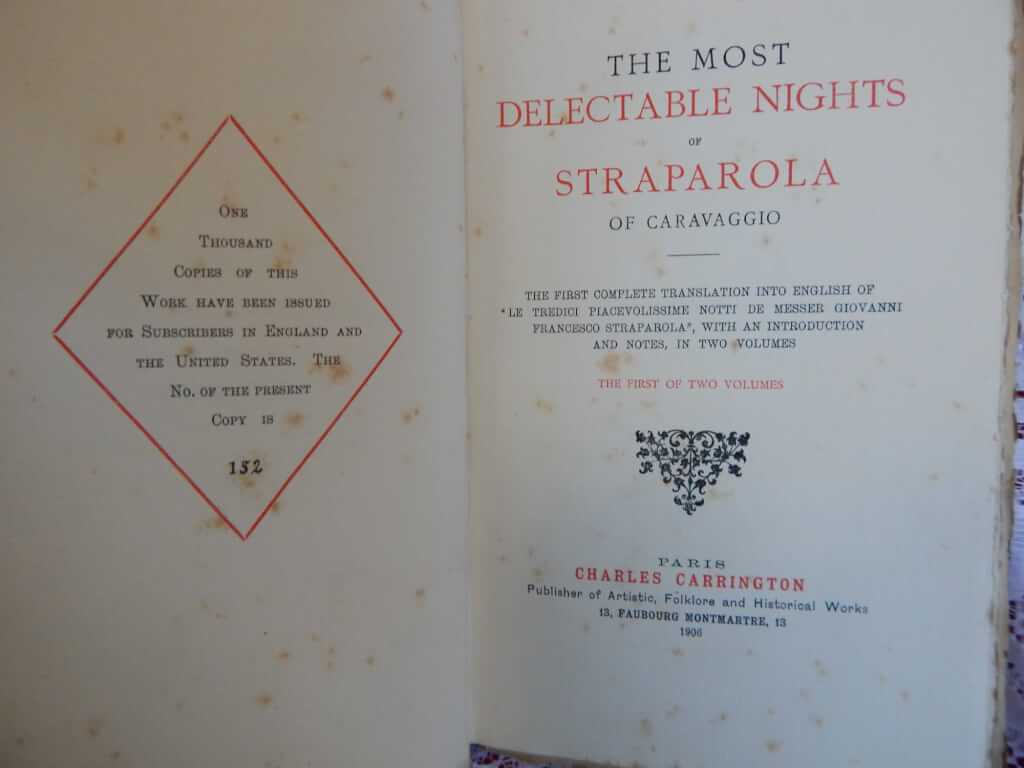
 The Most Delectable Nights of Straparola of Caravaggio, the first complete translation into english of "Le tredici piacevolissime notte, de Mesier Giovanni Francesco Straparola", with an introduction and notes, in two volumes, illust. by Léon Lebègue and Adolph Lambrecht (Charles Carrington, "Publisher of Artistic, Folklore and Historical Works", Paris, 1906, #152/1000, [first english translation, first edition] "Printed in Holland at the Printing Works of G. J. Thieme, Nymeguen.") 5.75"x8.5", 2 vol. xvi+352pp, xl+420pp, top edge gilt other edges deckled, blue boards with gilt borders and gilt lettering to the spines, red and black text and decorations throughout, numerous illustrations, both vignettes within text and tipped-in full color plates with descriptive tissue guards, handsome good+ copy for age, some foxing, small tear at top of vol. 1 spine, slight sunning to boards. This is a rare, beautifully executed, 1st edition, 1st English translation, 1st printing, low number limited edition, by Charles Carrington. Giovanni Francesco "Gianfrancesco" Straparola, also known as Zoan or Zuan Francesco Straparola da Caravaggio (1485?-1558) was a writer of poetry, and collector and writer of short stories. Some time during his life, he migrated from Caravaggio to Venice where he published a collection of stories in two volumes called Le piacevoli notti (1551 and 1553) (The Pleasant Nights, first translated by W. G. Waters in 1901 as "The Facetious Nights"). The Pleasant Nights is the work for which Straparola is most noted, and which contains a total of seventy-five short stories, fables, and fairy tales. The tales, or novelle, are divided into Nights, rather than chapters, and resemble the type of narrative presentation found in Boccaccio's Decameron. This presentation is of a gathering of Italian aristocrats, men and women, who entertain themselves by singing songs, dancing, telling stories and presenting enigmas (riddles). The Pleasant Nights contains many different types of tales, including realistic novellas, stories about practical jokes, tragic and triumphant love stories, bawdy tales, and animal stories. Some sixteen of these 74 tales are fairy tales including the story of Puss-in-Boots, the story of an impoverished boy whose enchanted cat earns him wealth, marriage to a princess, and a kingdom. Among the other fairy tales in The Pleasant Nights, we find a dragon slayer tale; the tale of a prince born in the shape of a pig due to a fairy’s curse who regains his human form only after marrying three time,; the story of Biancabella or “White Beauty” a princes who undergoes many trials until finally being saved by a fairy; and the a poor girl who acquire a magic doll that poops money and helps her marry a prince. It is claimed that many of the stories within The Pleasant Nights had been taken from earlier works, specifically from Girolamo Morlini, a 15th/16th century lawyer from Naples. If taken at his word, Straparola never denied this. In the Dedication at the front of the second volume, Straparola wrote that the stories ". . . written and collected in this volume [vol. 2 only?] are none of mine, but goods which I have feloniously taken from this man and that. Of a truth I confess they are not mine, and if I said otherwise I should lie, but nevertheless I have faithfully set them down according to the manner in which they were told by the ladies, nobles, learned men and gentlemen who gathered together for recreation."
The Most Delectable Nights of Straparola of Caravaggio, the first complete translation into english of "Le tredici piacevolissime notte, de Mesier Giovanni Francesco Straparola", with an introduction and notes, in two volumes, illust. by Léon Lebègue and Adolph Lambrecht (Charles Carrington, "Publisher of Artistic, Folklore and Historical Works", Paris, 1906, #152/1000, [first english translation, first edition] "Printed in Holland at the Printing Works of G. J. Thieme, Nymeguen.") 5.75"x8.5", 2 vol. xvi+352pp, xl+420pp, top edge gilt other edges deckled, blue boards with gilt borders and gilt lettering to the spines, red and black text and decorations throughout, numerous illustrations, both vignettes within text and tipped-in full color plates with descriptive tissue guards, handsome good+ copy for age, some foxing, small tear at top of vol. 1 spine, slight sunning to boards. This is a rare, beautifully executed, 1st edition, 1st English translation, 1st printing, low number limited edition, by Charles Carrington. Giovanni Francesco "Gianfrancesco" Straparola, also known as Zoan or Zuan Francesco Straparola da Caravaggio (1485?-1558) was a writer of poetry, and collector and writer of short stories. Some time during his life, he migrated from Caravaggio to Venice where he published a collection of stories in two volumes called Le piacevoli notti (1551 and 1553) (The Pleasant Nights, first translated by W. G. Waters in 1901 as "The Facetious Nights"). The Pleasant Nights is the work for which Straparola is most noted, and which contains a total of seventy-five short stories, fables, and fairy tales. The tales, or novelle, are divided into Nights, rather than chapters, and resemble the type of narrative presentation found in Boccaccio's Decameron. This presentation is of a gathering of Italian aristocrats, men and women, who entertain themselves by singing songs, dancing, telling stories and presenting enigmas (riddles). The Pleasant Nights contains many different types of tales, including realistic novellas, stories about practical jokes, tragic and triumphant love stories, bawdy tales, and animal stories. Some sixteen of these 74 tales are fairy tales including the story of Puss-in-Boots, the story of an impoverished boy whose enchanted cat earns him wealth, marriage to a princess, and a kingdom. Among the other fairy tales in The Pleasant Nights, we find a dragon slayer tale; the tale of a prince born in the shape of a pig due to a fairy’s curse who regains his human form only after marrying three time,; the story of Biancabella or “White Beauty” a princes who undergoes many trials until finally being saved by a fairy; and the a poor girl who acquire a magic doll that poops money and helps her marry a prince. It is claimed that many of the stories within The Pleasant Nights had been taken from earlier works, specifically from Girolamo Morlini, a 15th/16th century lawyer from Naples. If taken at his word, Straparola never denied this. In the Dedication at the front of the second volume, Straparola wrote that the stories ". . . written and collected in this volume [vol. 2 only?] are none of mine, but goods which I have feloniously taken from this man and that. Of a truth I confess they are not mine, and if I said otherwise I should lie, but nevertheless I have faithfully set them down according to the manner in which they were told by the ladies, nobles, learned men and gentlemen who gathered together for recreation." -

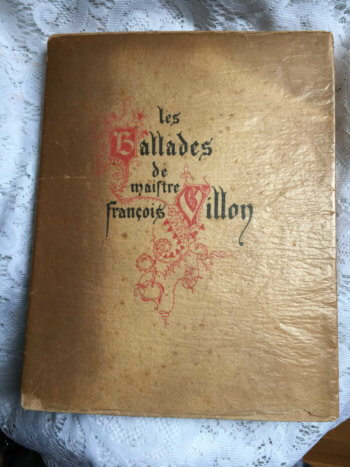 Les Ballades de Maistre Francois Villon, Francois Villon, illus. Chéri Hérouard, caligraphy ["escrites"] by Raymond de Rigné (chez Cres., Paris, 1919, #188/550 signed by Hérouard) 11.75" X 9.25", 169pp, original french wraps with glassine cover, 31 full page drawings by Hérouard plus 31 small vignette type illustrations. Beautifully printed on heavy deckle edged paper. good condition, all original, minor rubbing, slight foxing on outer pages, inner pages clean, rips in glassine cover at top and bottom of spine. François Villon (c. 1431_1464) was a French poet. Most of what is known about Villon has been gathered from legal records and gleaned from his own writings. He was a thief, killer, barroom brawler, and vagabond. He is perhaps best known for his Testaments and his Ballades. He was the most famous realist poet of the Middle Ages. Chéri Hérouard (1881 - 1961) was a French illustrator who was most famously known for his forty-five-year work for French society magazine, La Vie Parisienne. Under the pseudonym of Herric, he also created erotic and sadomasochistic illustrations for various books including the Kama Sutra.
Les Ballades de Maistre Francois Villon, Francois Villon, illus. Chéri Hérouard, caligraphy ["escrites"] by Raymond de Rigné (chez Cres., Paris, 1919, #188/550 signed by Hérouard) 11.75" X 9.25", 169pp, original french wraps with glassine cover, 31 full page drawings by Hérouard plus 31 small vignette type illustrations. Beautifully printed on heavy deckle edged paper. good condition, all original, minor rubbing, slight foxing on outer pages, inner pages clean, rips in glassine cover at top and bottom of spine. François Villon (c. 1431_1464) was a French poet. Most of what is known about Villon has been gathered from legal records and gleaned from his own writings. He was a thief, killer, barroom brawler, and vagabond. He is perhaps best known for his Testaments and his Ballades. He was the most famous realist poet of the Middle Ages. Chéri Hérouard (1881 - 1961) was a French illustrator who was most famously known for his forty-five-year work for French society magazine, La Vie Parisienne. Under the pseudonym of Herric, he also created erotic and sadomasochistic illustrations for various books including the Kama Sutra. -
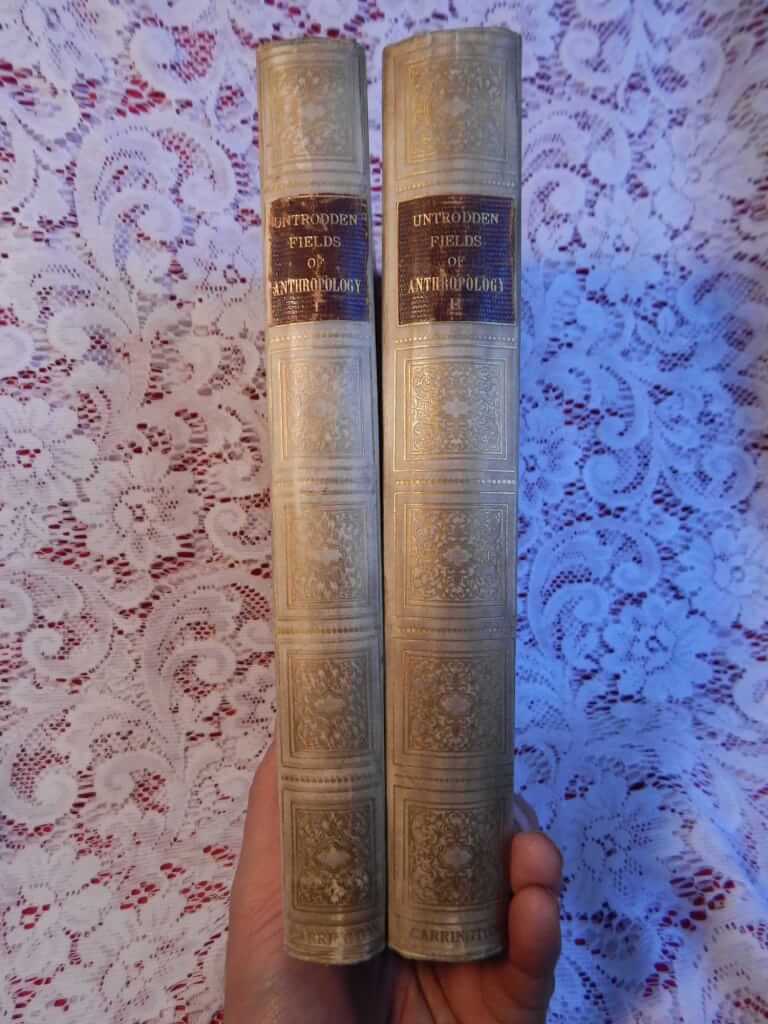
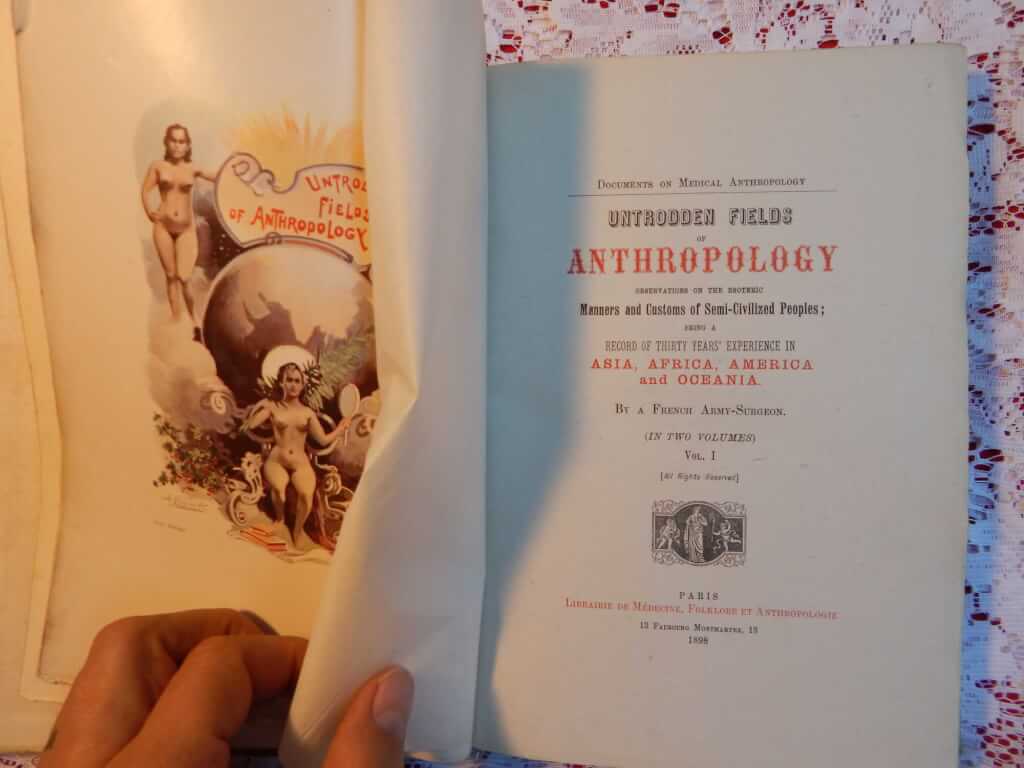 Documents on Medical Anthropology | Untrodden Fields of Anthropology | observations on the esoteric Manners and Customs of Semi-Civilized Peoples; being a record of thirty years' experience in asia, africa, america, and oceana., "By a French Army-Surgeon [in later books identified as "Jacobus X.."] (Charles Carrington, Paris, 1898, "second enlarged and revised edition [was there a first?]", #52/150, "printed on papier de chine") 7"x10" 2 vol., xl+ 341pp, xiv+502pp, Hardbound with paper wrappers inside, 1/2-bound in vellum over marbled boards, gilt lettering on spine, top edge gilt, other edges deckle/uncut, fine hand-laid paper, marlbled endpapers, binding tight, color frontispiece and numerous B&W full page engravings with descriptive tissue guards, very rare copy, bookplates of Frederic Roa This work of ''anthropology'' seems in fact intended to serve the purposes of titillation with its detailed descriptions of exotic sexual practices. Also present in this edition (to be presumably studied) are illustrations of naked women from all over the world. This is a rare book, often mentioned but not seen.
Documents on Medical Anthropology | Untrodden Fields of Anthropology | observations on the esoteric Manners and Customs of Semi-Civilized Peoples; being a record of thirty years' experience in asia, africa, america, and oceana., "By a French Army-Surgeon [in later books identified as "Jacobus X.."] (Charles Carrington, Paris, 1898, "second enlarged and revised edition [was there a first?]", #52/150, "printed on papier de chine") 7"x10" 2 vol., xl+ 341pp, xiv+502pp, Hardbound with paper wrappers inside, 1/2-bound in vellum over marbled boards, gilt lettering on spine, top edge gilt, other edges deckle/uncut, fine hand-laid paper, marlbled endpapers, binding tight, color frontispiece and numerous B&W full page engravings with descriptive tissue guards, very rare copy, bookplates of Frederic Roa This work of ''anthropology'' seems in fact intended to serve the purposes of titillation with its detailed descriptions of exotic sexual practices. Also present in this edition (to be presumably studied) are illustrations of naked women from all over the world. This is a rare book, often mentioned but not seen. -
 Memoirs of a Woman of Pleasure or The Life of Fanny Hill, John Cleland (Hoboken, np, 1929 [Philadelphia?] limited edition #621/700 first edition) 5 3/4″ X 8 1/4″, 211pp, quarter-bound red cloth over decorated boards, white label affixed to spine, color illustrations (rare) in an “art deco” style in similar to Aubrey Beardsley [or Elliot Dodd], excellent condition for age. Written while the author was in debtor’s prison in London and first published in 1749, Fanny Hill is considered the first original English prose pornography, and the first pornography to use the form of the novel. One of the most prosecuted and banned books in history, it has become a synonym for obscenity. The Hoboken copies of Fanny Hill are quite rare. This is the first edition original published c. 1929 with color illustrations and is extremely rare. An other edition appeared c. 1932 with the illustrations in black and white. It is unknown who the artist is but the illustrations are quite detailed and good.
Memoirs of a Woman of Pleasure or The Life of Fanny Hill, John Cleland (Hoboken, np, 1929 [Philadelphia?] limited edition #621/700 first edition) 5 3/4″ X 8 1/4″, 211pp, quarter-bound red cloth over decorated boards, white label affixed to spine, color illustrations (rare) in an “art deco” style in similar to Aubrey Beardsley [or Elliot Dodd], excellent condition for age. Written while the author was in debtor’s prison in London and first published in 1749, Fanny Hill is considered the first original English prose pornography, and the first pornography to use the form of the novel. One of the most prosecuted and banned books in history, it has become a synonym for obscenity. The Hoboken copies of Fanny Hill are quite rare. This is the first edition original published c. 1929 with color illustrations and is extremely rare. An other edition appeared c. 1932 with the illustrations in black and white. It is unknown who the artist is but the illustrations are quite detailed and good. -

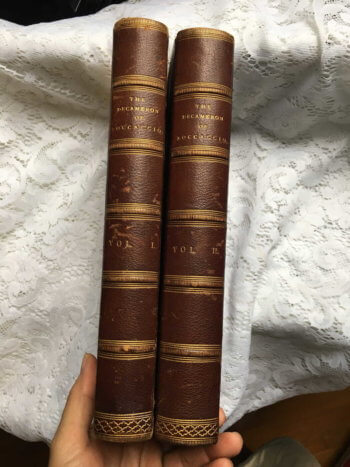 The Decameron of Giovanni Boccaccio, Giovanni Boccaccio, trans. John Payne, illust. Louis Chalon (Lawrence and Bullen, London, 1893, #32/1000 hand numbered, first edition thus) 11.25" X 7.5", 325pp 383pp, hardcover, half red morocco over red pebbled boards, gilt titles and decorations on spine, five raised bands, laid paper, top-edge gilt, marbled end papers, 15 full-page B&W Illustrations with tissue guards, good condition for age, some bumping to corners and slight wear, front endpapers on vol. 2 becoming detached but holding, a rare leather-bound copy of an low numbered limited edition. This is a beautifully leather-bound, nicely illustrated late nineteenth century edition of The Decameron from Lawrence and Bullen. The Decameron, (subtitled Prencipe Galeotto or Prince Galehaut), is a collection of novellas by the 14th-century Italian author Giovanni Boccaccio (1313–1375). The book is structured as a frame story containing 100 tales told by a group of seven young women and three young men sheltering in a secluded villa just outside Florence to escape the Black Death, which was afflicting the city. To make their exile more pleasant each of the ten tells the others one story every day. The Decameron records the narratives of ten days -- 100 stories. Boccaccio probably conceived of The Decameron after the epidemic of 1348, and completed it by 1353. These tales run the entire range of human emotion: grief, love, humor, anger, revenge. Many are based on oral folklore. Boccaccio's ten narrators thus retell already familiar stories about errant priests, rascally husbands, and mischievous wives. Variants of these stories are known in many cultures, but no one formulates them more cleverly or relates them more eloquently than does Boccaccio. In addition to its literary value and widespread influence, it provides a document of life at the time. Written in the vernacular of the Florentine language, it is considered a masterpiece of classical early Italian prose. Arthur Henry Bullen, often known as A. H. Bullen, (1857-1920) was an English editor and publisher, and a specialist in 16th and 17th century literature. His father George Bullen was librarian at the British Museum. A. H. Bullen's interest in Elizabethan dramatists and poets started at the City of London School, before he went to Worcester College, Oxford to study classics. His publishing career began with a scholarly edition of the Works of John Day in 1881 and continued with series of English Dramatists and a seven-volume set of Old English Plays, some of which he had discovered in manuscript and published for the first time. Bullen wrote more than 150 articles for the Dictionary of National Biography, lectured on Elizabethan dramatists at Oxford University and taught at Toynbee Hall. In 1891 he and H. W. Lawrence went into partnership as the publishers Lawrence & Bullen. This lasted until 1900 when Bullen moved on to publish as A. H. Bullen. With Frank Sidgwick as partner, he then formed the Shakespeare Head Press for which he is most known.
The Decameron of Giovanni Boccaccio, Giovanni Boccaccio, trans. John Payne, illust. Louis Chalon (Lawrence and Bullen, London, 1893, #32/1000 hand numbered, first edition thus) 11.25" X 7.5", 325pp 383pp, hardcover, half red morocco over red pebbled boards, gilt titles and decorations on spine, five raised bands, laid paper, top-edge gilt, marbled end papers, 15 full-page B&W Illustrations with tissue guards, good condition for age, some bumping to corners and slight wear, front endpapers on vol. 2 becoming detached but holding, a rare leather-bound copy of an low numbered limited edition. This is a beautifully leather-bound, nicely illustrated late nineteenth century edition of The Decameron from Lawrence and Bullen. The Decameron, (subtitled Prencipe Galeotto or Prince Galehaut), is a collection of novellas by the 14th-century Italian author Giovanni Boccaccio (1313–1375). The book is structured as a frame story containing 100 tales told by a group of seven young women and three young men sheltering in a secluded villa just outside Florence to escape the Black Death, which was afflicting the city. To make their exile more pleasant each of the ten tells the others one story every day. The Decameron records the narratives of ten days -- 100 stories. Boccaccio probably conceived of The Decameron after the epidemic of 1348, and completed it by 1353. These tales run the entire range of human emotion: grief, love, humor, anger, revenge. Many are based on oral folklore. Boccaccio's ten narrators thus retell already familiar stories about errant priests, rascally husbands, and mischievous wives. Variants of these stories are known in many cultures, but no one formulates them more cleverly or relates them more eloquently than does Boccaccio. In addition to its literary value and widespread influence, it provides a document of life at the time. Written in the vernacular of the Florentine language, it is considered a masterpiece of classical early Italian prose. Arthur Henry Bullen, often known as A. H. Bullen, (1857-1920) was an English editor and publisher, and a specialist in 16th and 17th century literature. His father George Bullen was librarian at the British Museum. A. H. Bullen's interest in Elizabethan dramatists and poets started at the City of London School, before he went to Worcester College, Oxford to study classics. His publishing career began with a scholarly edition of the Works of John Day in 1881 and continued with series of English Dramatists and a seven-volume set of Old English Plays, some of which he had discovered in manuscript and published for the first time. Bullen wrote more than 150 articles for the Dictionary of National Biography, lectured on Elizabethan dramatists at Oxford University and taught at Toynbee Hall. In 1891 he and H. W. Lawrence went into partnership as the publishers Lawrence & Bullen. This lasted until 1900 when Bullen moved on to publish as A. H. Bullen. With Frank Sidgwick as partner, he then formed the Shakespeare Head Press for which he is most known. -
 The Decameron, Giovanni Boccaccio, trans. John Payne, illus. Clara Tice (Boni & Liveright, New York, 1925, signed and hand numbered by “Boni and Liveright” #908/2000) 7.25″x10.5″, 2 vol., xxix+374pp, x+355pp, original black blind-stamped cloth boards with gilt titles on spine and decorations on front, boards have a front flap covering the fore-edge, printed on hand-laid paper with frontispiece and illustrations throughout, a beautifully executed edition. The Decameron, (subtitled Prencipe Galeotto or Prince Galehaut), is a collection of novellas by the 14th-century Italian author Giovanni Boccaccio (1313–1375). The book is structured as a frame story containing 100 tales told by a group of seven young women and three young men sheltering in a secluded villa just outside Florence to escape the Black Death, which was afflicting the city. To make their exile more pleasant each of the ten tells the others one story every day. The Decameron records the narratives of ten days — 100 stories. Boccaccio probably conceived of The Decameron after the epidemic of 1348, and completed it by 1353. These tales run the entire range of human emotion: grief, love, humor, anger, revenge. Many are based on oral folklore. Boccaccio’s ten narrators thus retell already familiar stories about errant priests, rascally husbands, and mischievous wives. Variants of these stories are known in many cultures, but no one formulates them more cleverly or relates them more eloquently than does Boccaccio. In addition to its literary value and widespread influence, it provides a document of life at the time. Written in the vernacular of the Florentine language, it is considered a masterpiece of classical early Italian prose. “This edition of the Decameron has been printed from the Caslon Old Face type set up by the Quinn and Boden Company, Rahway, N.J., on paper specially made by the Reading Paper Mills. The plates for the illustrations were made by the Wilbar Photo-Engraving Company, New York. Printed and bound by the Quinn and Boden Company. The whole plan of the book was made by T. R. Smith and executed by Manuel Komroff. Printed and bound, June, 1925”
The Decameron, Giovanni Boccaccio, trans. John Payne, illus. Clara Tice (Boni & Liveright, New York, 1925, signed and hand numbered by “Boni and Liveright” #908/2000) 7.25″x10.5″, 2 vol., xxix+374pp, x+355pp, original black blind-stamped cloth boards with gilt titles on spine and decorations on front, boards have a front flap covering the fore-edge, printed on hand-laid paper with frontispiece and illustrations throughout, a beautifully executed edition. The Decameron, (subtitled Prencipe Galeotto or Prince Galehaut), is a collection of novellas by the 14th-century Italian author Giovanni Boccaccio (1313–1375). The book is structured as a frame story containing 100 tales told by a group of seven young women and three young men sheltering in a secluded villa just outside Florence to escape the Black Death, which was afflicting the city. To make their exile more pleasant each of the ten tells the others one story every day. The Decameron records the narratives of ten days — 100 stories. Boccaccio probably conceived of The Decameron after the epidemic of 1348, and completed it by 1353. These tales run the entire range of human emotion: grief, love, humor, anger, revenge. Many are based on oral folklore. Boccaccio’s ten narrators thus retell already familiar stories about errant priests, rascally husbands, and mischievous wives. Variants of these stories are known in many cultures, but no one formulates them more cleverly or relates them more eloquently than does Boccaccio. In addition to its literary value and widespread influence, it provides a document of life at the time. Written in the vernacular of the Florentine language, it is considered a masterpiece of classical early Italian prose. “This edition of the Decameron has been printed from the Caslon Old Face type set up by the Quinn and Boden Company, Rahway, N.J., on paper specially made by the Reading Paper Mills. The plates for the illustrations were made by the Wilbar Photo-Engraving Company, New York. Printed and bound by the Quinn and Boden Company. The whole plan of the book was made by T. R. Smith and executed by Manuel Komroff. Printed and bound, June, 1925” -

 Nouvelles de Jean Boccace, Giovanni Boccaccio, trans. Mirabeau, illus. Marillier, engraved by Ponce [according to the Museum of Fine Arts - Boston, "Illustrated by Clément Pierre Marillier, Engraved by Wilbrode-Magloire-Nicolas Courbe, Engraved by Remi Henri Joseph Delvaux, Engraved by Nicholas Ponce, Etched by Devilliers, Author Giovanni Boccaccio, Publisher L. Duprat, Letellier et Cie, Printer A. Egron"] (Chez L. Duprat, Paris, 1802) 8" X 5.25", 4 vol. xx 304pp, 273pp, 243pp, 293pp, leather bound with gilt decorations on spine and around edges of boards, marbled end papers, armorial bookplate of the Earl of Normanton on all vols. gilt edges (mostly soiled). Owner's signature on front pages "A. Baillu 1819" Ribbons intact. Numerous beautifuly and detailed plates throughout. Good condition for age. Honoré Gabriel Riqueti, Comte de Mirabeau (1749-1791) was a French writer, popular orator and statesman (who communicated with Thomas Jefferson and Benjamin Franklin). He is remembered for his books Erotica biblion, Ma conversion, and his love letters to Sophie which written during his imprisonment at the donjon de Vincennes between 1777-1780 (while another prisoner, the Marquis de Sade was also incarcerated there. Yes, they met... No, they didn't like each other.) This book was also written in the Vincennes prison. According to Mirabeau's biography this was a "collection presented as a translation of Boccaccio, but which, as the author himself confesses in his introduction, is nothing more than simple sketches of some of the tales in the Decameron.... Mirabeau imitated some of the licentious tales which alone are known to the general reader, but took no notice of the other articles which abound in the Decameron, because they neither suited his views nor the public taste." A beautiful and rare book with exquisite engravings. This book is in the collection at the MFA-Boston and other museums.
Nouvelles de Jean Boccace, Giovanni Boccaccio, trans. Mirabeau, illus. Marillier, engraved by Ponce [according to the Museum of Fine Arts - Boston, "Illustrated by Clément Pierre Marillier, Engraved by Wilbrode-Magloire-Nicolas Courbe, Engraved by Remi Henri Joseph Delvaux, Engraved by Nicholas Ponce, Etched by Devilliers, Author Giovanni Boccaccio, Publisher L. Duprat, Letellier et Cie, Printer A. Egron"] (Chez L. Duprat, Paris, 1802) 8" X 5.25", 4 vol. xx 304pp, 273pp, 243pp, 293pp, leather bound with gilt decorations on spine and around edges of boards, marbled end papers, armorial bookplate of the Earl of Normanton on all vols. gilt edges (mostly soiled). Owner's signature on front pages "A. Baillu 1819" Ribbons intact. Numerous beautifuly and detailed plates throughout. Good condition for age. Honoré Gabriel Riqueti, Comte de Mirabeau (1749-1791) was a French writer, popular orator and statesman (who communicated with Thomas Jefferson and Benjamin Franklin). He is remembered for his books Erotica biblion, Ma conversion, and his love letters to Sophie which written during his imprisonment at the donjon de Vincennes between 1777-1780 (while another prisoner, the Marquis de Sade was also incarcerated there. Yes, they met... No, they didn't like each other.) This book was also written in the Vincennes prison. According to Mirabeau's biography this was a "collection presented as a translation of Boccaccio, but which, as the author himself confesses in his introduction, is nothing more than simple sketches of some of the tales in the Decameron.... Mirabeau imitated some of the licentious tales which alone are known to the general reader, but took no notice of the other articles which abound in the Decameron, because they neither suited his views nor the public taste." A beautiful and rare book with exquisite engravings. This book is in the collection at the MFA-Boston and other museums. -

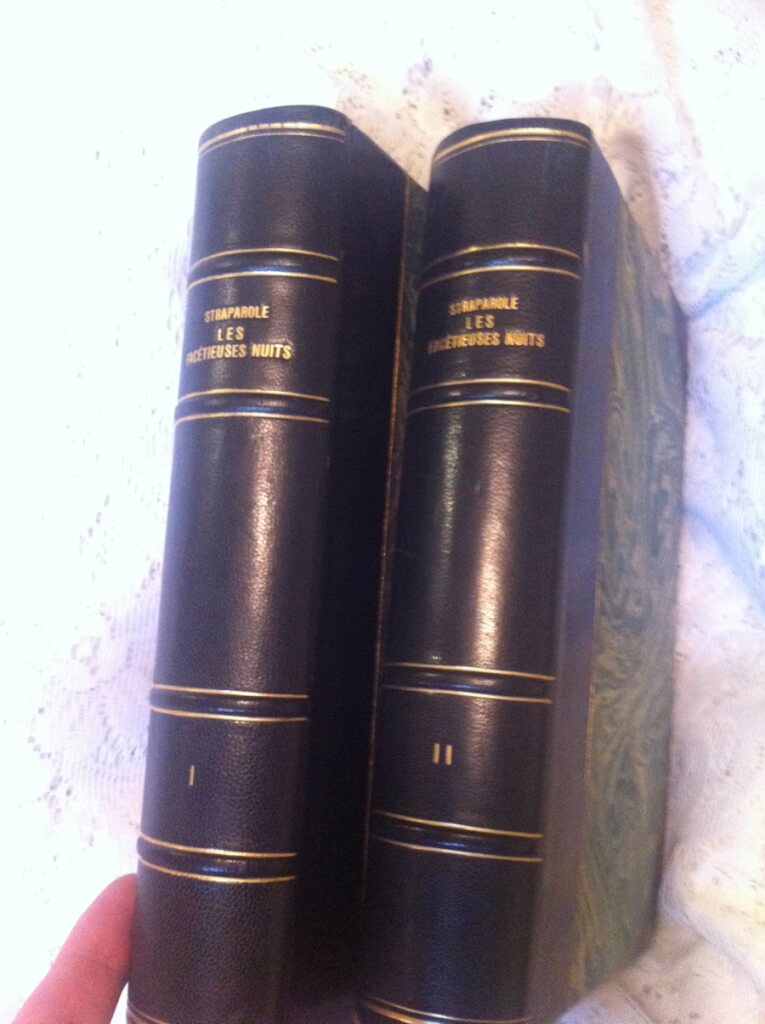 Les Facetieuses Nuits de Straparole, Giovanni Francesco Straparola, trans. Jean Louveau, illus. L_on Lebègue. Preface by Jules de Marthold (Charles Carrington, Paris, 1907 #213/800) 9.5" x 6.25", 2 vol. lxxxvii+312pp. vi+371pp. 1/2 leather over marbled boards, 4 raised bands on spine gilt lettering and decorations, marbled endpapers, gilted top-edge, others deckled, many color illustrations protected by tissues with descrptions printed on them, text decorations throughout, near fine condition, book binder tag for "Hans Uttinger, Buchbinderei, Einrahmungsgeschäft, Luzern" The Facetious Nights of Straparola (1550-1555; Italian: Le piacevoli notti), also known as The Nights of Straparola, is a two-volume collection of 75 stories by Italian author and fairy-tale collector Giovanni Francesco Straparola(c.1480-c.1557). Modeled after Bocaccio's Decameron, it has participants of a 13-night party in the island of Murano, near Venice, tell each other stories that vary from bawdy to fantastic. It contains the first known written versions of many fairy tales. It would influence later fairy-tale authors like Charles Perrault and Jacob and Wilhelm Grimm. This book is a very rare and famous (and famously illustrated) edition. A beautiful copy of a beautifully made book.
Les Facetieuses Nuits de Straparole, Giovanni Francesco Straparola, trans. Jean Louveau, illus. L_on Lebègue. Preface by Jules de Marthold (Charles Carrington, Paris, 1907 #213/800) 9.5" x 6.25", 2 vol. lxxxvii+312pp. vi+371pp. 1/2 leather over marbled boards, 4 raised bands on spine gilt lettering and decorations, marbled endpapers, gilted top-edge, others deckled, many color illustrations protected by tissues with descrptions printed on them, text decorations throughout, near fine condition, book binder tag for "Hans Uttinger, Buchbinderei, Einrahmungsgeschäft, Luzern" The Facetious Nights of Straparola (1550-1555; Italian: Le piacevoli notti), also known as The Nights of Straparola, is a two-volume collection of 75 stories by Italian author and fairy-tale collector Giovanni Francesco Straparola(c.1480-c.1557). Modeled after Bocaccio's Decameron, it has participants of a 13-night party in the island of Murano, near Venice, tell each other stories that vary from bawdy to fantastic. It contains the first known written versions of many fairy tales. It would influence later fairy-tale authors like Charles Perrault and Jacob and Wilhelm Grimm. This book is a very rare and famous (and famously illustrated) edition. A beautiful copy of a beautifully made book. -
 Les métamorphoses ou l’asne d’or de Luce Apulée philosophe platonique, Lucius Apuleius Madaurensis (124-170 AD), trans. Jules De Montlyald, preface by Jules de Marthold, illust. [21 etchings] Martin van Maele (Charles Carrington, Librairie-Éditeur, 1905, Paris, #115/750) 6.25" X 9.25", xlviii+328pp, beautifully bound in three-quarter morocco over marbled boards with gilt titles and decorations on the spine, top-edge gilt, others uncut, fine condition overall, 21 full-page tipped-in B/W engravings with tissue guards and numerous in-text illustrations by Martin van Meale, red ribbon intact. The Metamorphoses of Apuleius, which St. Augustine referred to as “The Golden Ass”, is the only Ancient Roman novel in Latin to survive in its entirety. The plot Lucius and his curiosity and insatiable desire to see and practice magic. While trying to perform a spell to transform into a bird, he is accidentally transformed into an ass. This leads to a long journey, literal and metaphorical, filled with in-set tales. He finally finds salvation through the intervention of the goddess Isis, whose cult he joins. The date of the original work is uncertain. Scholars are not sure if he wrote it in his youth or at the end of his life. He adapted the story from a Greek story written by Lucius of Patrae, however his original Greek text has long been lost. Maurice François Alfred Martin van Miële (1863-5 – 1926), better known by his pseudonym Martin van Maële, was a French illustrator of early 20th century literature. Though he gained notoriety with his illustration for H. G. Wells in Les Premiers Hommes dans la Lune, and he worked as an illustrator for the Félix Juven’s French translations of the Sherlock Holmes series, he is now most widely renowned and mostly remembered for his erotic illustrations.
Les métamorphoses ou l’asne d’or de Luce Apulée philosophe platonique, Lucius Apuleius Madaurensis (124-170 AD), trans. Jules De Montlyald, preface by Jules de Marthold, illust. [21 etchings] Martin van Maele (Charles Carrington, Librairie-Éditeur, 1905, Paris, #115/750) 6.25" X 9.25", xlviii+328pp, beautifully bound in three-quarter morocco over marbled boards with gilt titles and decorations on the spine, top-edge gilt, others uncut, fine condition overall, 21 full-page tipped-in B/W engravings with tissue guards and numerous in-text illustrations by Martin van Meale, red ribbon intact. The Metamorphoses of Apuleius, which St. Augustine referred to as “The Golden Ass”, is the only Ancient Roman novel in Latin to survive in its entirety. The plot Lucius and his curiosity and insatiable desire to see and practice magic. While trying to perform a spell to transform into a bird, he is accidentally transformed into an ass. This leads to a long journey, literal and metaphorical, filled with in-set tales. He finally finds salvation through the intervention of the goddess Isis, whose cult he joins. The date of the original work is uncertain. Scholars are not sure if he wrote it in his youth or at the end of his life. He adapted the story from a Greek story written by Lucius of Patrae, however his original Greek text has long been lost. Maurice François Alfred Martin van Miële (1863-5 – 1926), better known by his pseudonym Martin van Maële, was a French illustrator of early 20th century literature. Though he gained notoriety with his illustration for H. G. Wells in Les Premiers Hommes dans la Lune, and he worked as an illustrator for the Félix Juven’s French translations of the Sherlock Holmes series, he is now most widely renowned and mostly remembered for his erotic illustrations. -
 The Golden Ass of Apuleius, a new translation with introduction and notes by Francis D. Byrne, Lucius Apuleius Madaurensis (124-170 AD), trans. Francis D Byrne, illust. [20 etchings] Martin van Maele (Classical Translation Union, Privately Issued for the Subscribers [Charles Carrington], 1904, Paris, #304/750) 6" X 8", xlix+588pp, blue boards with gilt decorations and titles, top-edge gilt, others deckled, some light foxing in the first few pages, advertisements on last few pages (all Carrington works). The Metamorphoses of Apuleius, which St. Augustine referred to as “The Golden Ass”, is the only Ancient Roman novel in Latin to survive in its entirety. The plot Lucius and his curiosity and insatiable desire to see and practice magic. While trying to perform a spell to transform into a bird, he is accidentally transformed into an ass. This leads to a long journey, literal and metaphorical, filled with in-set tales. He finally finds salvation through the intervention of the goddess Isis, whose cult he joins. The date of the original work is uncertain. Scholars are not sure if he wrote it in his youth or at the end of his life. He adapted the story from a Greek story written by Lucius of Patrae, however his original Greek text has long been lost. Maurice François Alfred Martin van Miële (1863-5 – 1926), better known by his pseudonym Martin van Maële, was a French illustrator of early 20th century literature. Though he gained notoriety with his illustration for H. G. Wells in Les Premiers Hommes dans la Lune, and he worked as an illustrator for the Félix Juven’s French translations of the Sherlock Holmes series, he is now most widely renowned and mostly remembered for his erotic illustrations.
The Golden Ass of Apuleius, a new translation with introduction and notes by Francis D. Byrne, Lucius Apuleius Madaurensis (124-170 AD), trans. Francis D Byrne, illust. [20 etchings] Martin van Maele (Classical Translation Union, Privately Issued for the Subscribers [Charles Carrington], 1904, Paris, #304/750) 6" X 8", xlix+588pp, blue boards with gilt decorations and titles, top-edge gilt, others deckled, some light foxing in the first few pages, advertisements on last few pages (all Carrington works). The Metamorphoses of Apuleius, which St. Augustine referred to as “The Golden Ass”, is the only Ancient Roman novel in Latin to survive in its entirety. The plot Lucius and his curiosity and insatiable desire to see and practice magic. While trying to perform a spell to transform into a bird, he is accidentally transformed into an ass. This leads to a long journey, literal and metaphorical, filled with in-set tales. He finally finds salvation through the intervention of the goddess Isis, whose cult he joins. The date of the original work is uncertain. Scholars are not sure if he wrote it in his youth or at the end of his life. He adapted the story from a Greek story written by Lucius of Patrae, however his original Greek text has long been lost. Maurice François Alfred Martin van Miële (1863-5 – 1926), better known by his pseudonym Martin van Maële, was a French illustrator of early 20th century literature. Though he gained notoriety with his illustration for H. G. Wells in Les Premiers Hommes dans la Lune, and he worked as an illustrator for the Félix Juven’s French translations of the Sherlock Holmes series, he is now most widely renowned and mostly remembered for his erotic illustrations. -
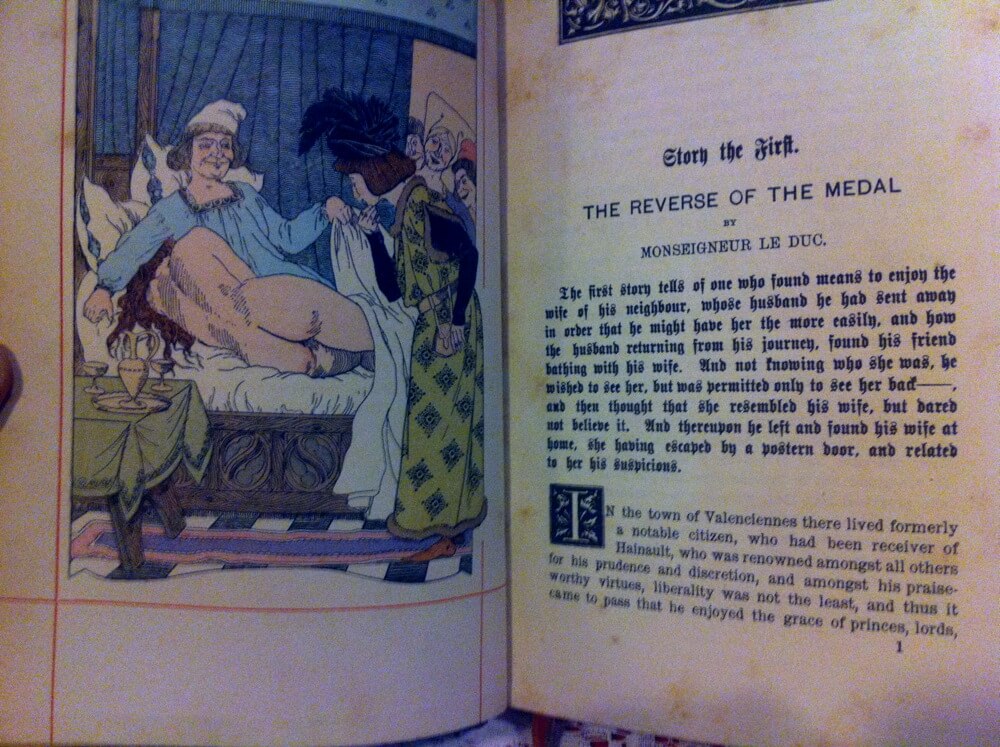
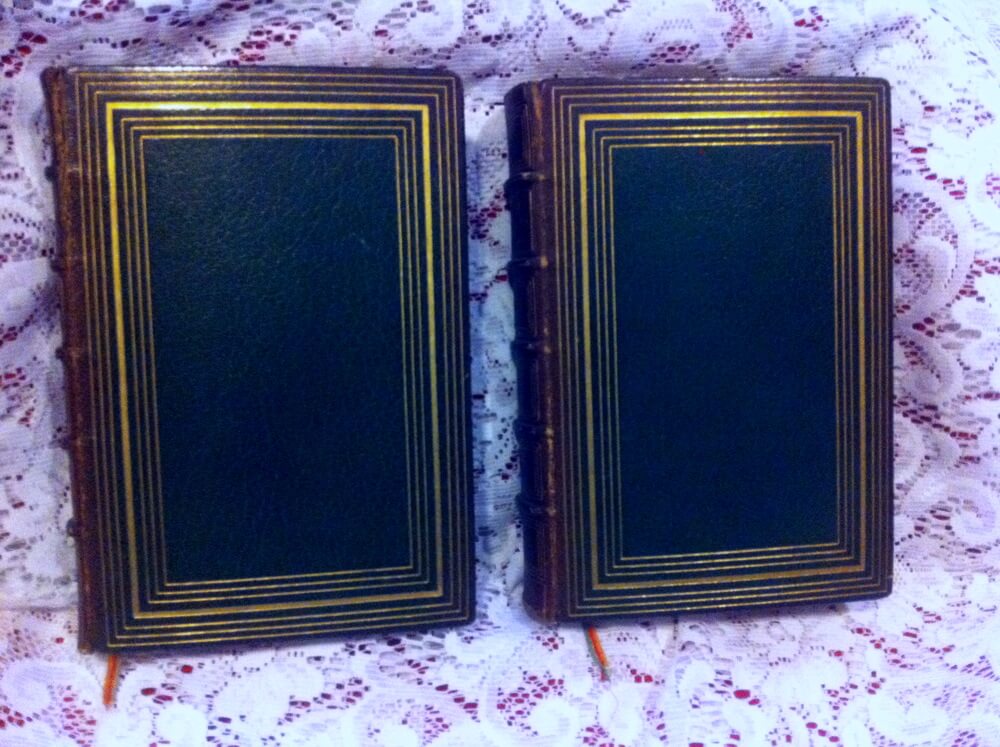 One Hundred Merrie and Delightsome Stories, ed. by Antoine de La Sale, trans. Robert B. Douglas, illust. Leon Lebegue, illust. Adolphe Lalauze (Charles Carrington, Paris, 1899 [first edition, first english translation]) 8" X 5.75", vol 1. 1-256, vol 2. 257-532, full morocco leather, olive green to maroon, gilt decorations, 5 raised bands, marbled endpapers with gilt edging on pastedowns, excellent condition for age, includes complete set of 52 hand-colored plates by Lebegue (originally sold separately) as well as complete set of 10 engravings by AD LaLuze after art by Jules Garnier, vol. 1 ribbon present but detatched, vol. 2. ribbon intact. Charles Carrington was the first to have this translated into English. This is a RARE full-leather version with ALL 52 colored plates! Also rare are the 10 engravings by LaLauze, which originally appeared in a French version. Purported a collection of short stories narrated by various persons at the court of Philippe le Bon, and collected together by Antoine de la Sale, the nouvelles are, according to the authority on French Literature—Professor George Saintsbury "undoubtedly the first work of literary prose in French ... The short prose tale of a comic character is the one French literary product the pre-eminence and perfection of which it is impossible to dispute, and the prose tale first appears to advantage in the Cent Nouvelles Nouvelles." The stories give a curious glimpses of life in the 15th century, providing a genuine view of the social condition of the nobility and the middle classes. M. Lenient, a French critic, says: "Generally the incidents and personages belong to the bourgeoisée; there is nothing chivalric, nothing wonderful; no dreamy lovers, romantic dames, fairies, or enchanters. Noble dames, bourgeois, nuns, knights, merchants, monks, and peasants mutually dupe each other. The lord deceives the miller's wife by imposing on her simplicity, and the miller retaliates in much the same manner. The shepherd marries the knight's sister, and the nobleman is not over scandalized. The vices of the monks are depicted in half a score tales, and the seducers are punished with a severity not always in proportion to the offence." For four centuries 10 of the stories were credited to Louis XI. Modern scholars have since ascribed them to either Philippe le Bel or Comte de Charolais. In all, some thirty-two noblemen or squires contributed the stories, with some 14 or 15 taken from Giovanni Boccaccio, and as many more from Gian Francesco Poggio Bracciolini or other Italian writers, or French fabliaux, but about 70 of them appear to be original.
One Hundred Merrie and Delightsome Stories, ed. by Antoine de La Sale, trans. Robert B. Douglas, illust. Leon Lebegue, illust. Adolphe Lalauze (Charles Carrington, Paris, 1899 [first edition, first english translation]) 8" X 5.75", vol 1. 1-256, vol 2. 257-532, full morocco leather, olive green to maroon, gilt decorations, 5 raised bands, marbled endpapers with gilt edging on pastedowns, excellent condition for age, includes complete set of 52 hand-colored plates by Lebegue (originally sold separately) as well as complete set of 10 engravings by AD LaLuze after art by Jules Garnier, vol. 1 ribbon present but detatched, vol. 2. ribbon intact. Charles Carrington was the first to have this translated into English. This is a RARE full-leather version with ALL 52 colored plates! Also rare are the 10 engravings by LaLauze, which originally appeared in a French version. Purported a collection of short stories narrated by various persons at the court of Philippe le Bon, and collected together by Antoine de la Sale, the nouvelles are, according to the authority on French Literature—Professor George Saintsbury "undoubtedly the first work of literary prose in French ... The short prose tale of a comic character is the one French literary product the pre-eminence and perfection of which it is impossible to dispute, and the prose tale first appears to advantage in the Cent Nouvelles Nouvelles." The stories give a curious glimpses of life in the 15th century, providing a genuine view of the social condition of the nobility and the middle classes. M. Lenient, a French critic, says: "Generally the incidents and personages belong to the bourgeoisée; there is nothing chivalric, nothing wonderful; no dreamy lovers, romantic dames, fairies, or enchanters. Noble dames, bourgeois, nuns, knights, merchants, monks, and peasants mutually dupe each other. The lord deceives the miller's wife by imposing on her simplicity, and the miller retaliates in much the same manner. The shepherd marries the knight's sister, and the nobleman is not over scandalized. The vices of the monks are depicted in half a score tales, and the seducers are punished with a severity not always in proportion to the offence." For four centuries 10 of the stories were credited to Louis XI. Modern scholars have since ascribed them to either Philippe le Bel or Comte de Charolais. In all, some thirty-two noblemen or squires contributed the stories, with some 14 or 15 taken from Giovanni Boccaccio, and as many more from Gian Francesco Poggio Bracciolini or other Italian writers, or French fabliaux, but about 70 of them appear to be original. -
 Manual of Classical Erotology (de figuris Veneris) by Fred. Chas. Forberg, trans. Alcide Bonneau (Privately Printed for Viscount Julian Smithson M. A. and Friends [Charles Carrington], 1884, one of 100 copies) vol. 2 only, half-bound in tan vellum over marbled boards, spine is labeled "Carrington" who is the presumed publisher. Top edge gilt, other edges deckled, binding loose but holding. De figuris Veneris (On the figures of Venus) was an anthology of ancient Greek and ancient Roman writings on erotic topics, discussed objectively and classified and grouped by subject matter. It was first published by the German classicist Friedrich Karl Forberg in 1824 in Latin and Greek as a commentary to Antonio Beccadelli's (1394-1471) Hermaphroditus (commonly referred to as Antonii Panormitae Hermaphroditus), an erotic poem sequence of 1425 in renaissance Latin, though it was later also published as a separate work. First edition of this important parallel English, Latin and Greek version. This very rare edition was translated by Alcide Bonneau and published by Charles Carrington. Each page has latin (and where appropriate, Greek) on the right side and the English translation on the left. This is the second volume only and includes the following chapters: IV. —Of Masturbation V. —Of Cunnilingues VI. —Of Tribads VII. —Of Intercourse with Animals VIII. —Of Spintrian Postures (a list of 95 sexual positions) Considered the gold standard English translation of the time, this edition followed a poor piracy of 1882 badly translated from Liseux’s French edition of 1882. The name of the publisher is missing (most likely to avoid prosecution) and the limitation statement says 100 copies were "printed for Viscount Julian Smithson M. A., the Translator, and his Friends" and further states that "None of these Copies are for Sale" (also to avoid prosecution). Through later statements (mostly by association) we know it was published by Charles Carrington and translated by Alcide Bonneau. Carrington, in his 1902 catalogue, Forbidden Books wrote (thus promoting the sale of his clandestinely published book): ‘Were I a bookseller, I do not think I should ever take the trouble to print such a book as I have now before me. Here is a Latin work, full of notes, and bristling with Greek quotations. A most careful and masterly translation has been placed opposite every page of the original text, and it needs no literary critic to see that no one but a real classical scholar—an old Oxford man—could ever have successfully struggled with such a task... The two stout volumes have evidently been printed on the Continent—and for very good and valid reasons, as no English printer would dare to undertake such a work,— therefore each page would have to be submitted to the translator, at least three or four times, foreign compositors working mechanically. Many months would thus pass in wearisome proof-reading, and when at last the hundred copies are struck off, and each man receives his due, what margin of profit awaits the silly bookseller-publisher? He is insulted in every way and laughed at if he dares to wonder that the British Customs seize any copies...’ In 1882 Forberg's work was translated into English and published by Charles Carrington as De figuris Veneris, Manual of classical erotology, and again in 1907 by Charles Hirsch, and into French, German and Spanish. The French edition by Alcide Bonneau was titled Manuel d’érotologie classique. One French edition of 1906 was illustrated by Édouard-Henri Avril, which concludes with a list of 95 sexual positions. Most of the editions were restricted to high society or censored; one of the copies edited in France was immediately deposited on the secret shelves of the Bibliothèque nationale de France.
Manual of Classical Erotology (de figuris Veneris) by Fred. Chas. Forberg, trans. Alcide Bonneau (Privately Printed for Viscount Julian Smithson M. A. and Friends [Charles Carrington], 1884, one of 100 copies) vol. 2 only, half-bound in tan vellum over marbled boards, spine is labeled "Carrington" who is the presumed publisher. Top edge gilt, other edges deckled, binding loose but holding. De figuris Veneris (On the figures of Venus) was an anthology of ancient Greek and ancient Roman writings on erotic topics, discussed objectively and classified and grouped by subject matter. It was first published by the German classicist Friedrich Karl Forberg in 1824 in Latin and Greek as a commentary to Antonio Beccadelli's (1394-1471) Hermaphroditus (commonly referred to as Antonii Panormitae Hermaphroditus), an erotic poem sequence of 1425 in renaissance Latin, though it was later also published as a separate work. First edition of this important parallel English, Latin and Greek version. This very rare edition was translated by Alcide Bonneau and published by Charles Carrington. Each page has latin (and where appropriate, Greek) on the right side and the English translation on the left. This is the second volume only and includes the following chapters: IV. —Of Masturbation V. —Of Cunnilingues VI. —Of Tribads VII. —Of Intercourse with Animals VIII. —Of Spintrian Postures (a list of 95 sexual positions) Considered the gold standard English translation of the time, this edition followed a poor piracy of 1882 badly translated from Liseux’s French edition of 1882. The name of the publisher is missing (most likely to avoid prosecution) and the limitation statement says 100 copies were "printed for Viscount Julian Smithson M. A., the Translator, and his Friends" and further states that "None of these Copies are for Sale" (also to avoid prosecution). Through later statements (mostly by association) we know it was published by Charles Carrington and translated by Alcide Bonneau. Carrington, in his 1902 catalogue, Forbidden Books wrote (thus promoting the sale of his clandestinely published book): ‘Were I a bookseller, I do not think I should ever take the trouble to print such a book as I have now before me. Here is a Latin work, full of notes, and bristling with Greek quotations. A most careful and masterly translation has been placed opposite every page of the original text, and it needs no literary critic to see that no one but a real classical scholar—an old Oxford man—could ever have successfully struggled with such a task... The two stout volumes have evidently been printed on the Continent—and for very good and valid reasons, as no English printer would dare to undertake such a work,— therefore each page would have to be submitted to the translator, at least three or four times, foreign compositors working mechanically. Many months would thus pass in wearisome proof-reading, and when at last the hundred copies are struck off, and each man receives his due, what margin of profit awaits the silly bookseller-publisher? He is insulted in every way and laughed at if he dares to wonder that the British Customs seize any copies...’ In 1882 Forberg's work was translated into English and published by Charles Carrington as De figuris Veneris, Manual of classical erotology, and again in 1907 by Charles Hirsch, and into French, German and Spanish. The French edition by Alcide Bonneau was titled Manuel d’érotologie classique. One French edition of 1906 was illustrated by Édouard-Henri Avril, which concludes with a list of 95 sexual positions. Most of the editions were restricted to high society or censored; one of the copies edited in France was immediately deposited on the secret shelves of the Bibliothèque nationale de France. -
 40 prints from “Liebe. Vierzig Zeichnungen”, Mihály Zichy (n.d. n.p. [1911-13]) 11.25″ X 13.5″, 40pp unnumbered, bound in half-morocco with gilt edges over red boards, gilt titles and decorations on spine, all 40 original plates are present and bound together in what appears to be a contemporary binding, good condition, some foxing throughout. Mihály Zichy (1827 – 1906) was a Hungarian painter and graphic artist. He is considered a notable representative of Hungarian romantic painting. He lived and worked primarily in St. Petersburg and Paris during his career. He is known for illustrating the Georgian epic poem The Knight in the Panther's Skin on an 1881 commission by the intelligentsia. By the time he had completed 35 pictures, he was so moved by the poem that he gave his works to the Georgian people as a gift. In 1911 40 héliogravures after Zichy’s erotic drawings were published as “Liebe. Vierzig Zeichnungen” [Love. 40 drawings]. The subjects were bold, provocative, and at times taboo. Only 300 copies were printed, only for subscribers. There was also a very rare limited printing in 1913 before the plates were destroyed. As far as I can tell these appear to be the prints taken from that one of those editions, and rebound here without the title page that accompanied the published work.
40 prints from “Liebe. Vierzig Zeichnungen”, Mihály Zichy (n.d. n.p. [1911-13]) 11.25″ X 13.5″, 40pp unnumbered, bound in half-morocco with gilt edges over red boards, gilt titles and decorations on spine, all 40 original plates are present and bound together in what appears to be a contemporary binding, good condition, some foxing throughout. Mihály Zichy (1827 – 1906) was a Hungarian painter and graphic artist. He is considered a notable representative of Hungarian romantic painting. He lived and worked primarily in St. Petersburg and Paris during his career. He is known for illustrating the Georgian epic poem The Knight in the Panther's Skin on an 1881 commission by the intelligentsia. By the time he had completed 35 pictures, he was so moved by the poem that he gave his works to the Georgian people as a gift. In 1911 40 héliogravures after Zichy’s erotic drawings were published as “Liebe. Vierzig Zeichnungen” [Love. 40 drawings]. The subjects were bold, provocative, and at times taboo. Only 300 copies were printed, only for subscribers. There was also a very rare limited printing in 1913 before the plates were destroyed. As far as I can tell these appear to be the prints taken from that one of those editions, and rebound here without the title page that accompanied the published work. -
 Manuel d'érotologie classique (De figuris veneris). Traduit littéralement du latin par Isidore Liseux et illustré de 20 compositions originales, by Fred. Chas. [translated by d'Alcide Bonneau and not Liseux as noted] (np [Charles Hirsch], Paris, 1906, #106/500 one of 120 printed on Hollande paper) 8.5" X 11.5", viii+167(1)pp, bound in half burgundy morocco over marbled crimson boards, gilt titles and decorations on spine, 5 raised bands, good+ condition, some bumping/rubbing to boards, very famous b&w frontispiece and 19 illustrations by Paul Avril, some soiling/foxing to illustrations, a beautiful and rare book in very good condition. De figuris Veneris (On the figures of Venus) was an anthology of ancient Greek and ancient Roman writings on erotic topics, discussed objectively and classified and grouped by subject matter. It was first published by the German classicist Friedrich Karl Forberg in 1824 in Latin and Greek as a commentary to Antonio Beccadelli's (1394-1471) Hermaphroditus (commonly referred to as Antonii Panormitae Hermaphroditus), an erotic poem sequence of 1425 in renaissance Latin, though it was later also published as a separate work. Chapters are: I. Of Copulation II. Of Pederastia III. Of Irrumation IV. Of Masturbation V. Of Cunnilingues VI. Of Tribads VII. Of Intercourse with Animals VIII. Of Spintrian Postures In 1882 Forberg's work was translated into English and published by Charles Carrington as De figuris Veneris, Manual of classical erotology, and again in 1907 by Charles Hirsch, and into French, German and Spanish. The French edition by Alcide Bonneau was titled Manuel d’érotologie classique. One French edition of 1906 was illustrated by Édouard-Henri Avril, which concludes with a list of 95 sexual positions. Most of the editions were restricted to high society or censored; one of the copies edited in France was immediately deposited on the secret shelves of the Bibliothèque nationale de France. Hirsch's printed 500 copies of this 1906 edition. 20 were on Japan paper, 120 were on Holland paper, 340 were are Arches paper, and 20 were on "anglais" paper. This is one of 120 on Holland paper.
Manuel d'érotologie classique (De figuris veneris). Traduit littéralement du latin par Isidore Liseux et illustré de 20 compositions originales, by Fred. Chas. [translated by d'Alcide Bonneau and not Liseux as noted] (np [Charles Hirsch], Paris, 1906, #106/500 one of 120 printed on Hollande paper) 8.5" X 11.5", viii+167(1)pp, bound in half burgundy morocco over marbled crimson boards, gilt titles and decorations on spine, 5 raised bands, good+ condition, some bumping/rubbing to boards, very famous b&w frontispiece and 19 illustrations by Paul Avril, some soiling/foxing to illustrations, a beautiful and rare book in very good condition. De figuris Veneris (On the figures of Venus) was an anthology of ancient Greek and ancient Roman writings on erotic topics, discussed objectively and classified and grouped by subject matter. It was first published by the German classicist Friedrich Karl Forberg in 1824 in Latin and Greek as a commentary to Antonio Beccadelli's (1394-1471) Hermaphroditus (commonly referred to as Antonii Panormitae Hermaphroditus), an erotic poem sequence of 1425 in renaissance Latin, though it was later also published as a separate work. Chapters are: I. Of Copulation II. Of Pederastia III. Of Irrumation IV. Of Masturbation V. Of Cunnilingues VI. Of Tribads VII. Of Intercourse with Animals VIII. Of Spintrian Postures In 1882 Forberg's work was translated into English and published by Charles Carrington as De figuris Veneris, Manual of classical erotology, and again in 1907 by Charles Hirsch, and into French, German and Spanish. The French edition by Alcide Bonneau was titled Manuel d’érotologie classique. One French edition of 1906 was illustrated by Édouard-Henri Avril, which concludes with a list of 95 sexual positions. Most of the editions were restricted to high society or censored; one of the copies edited in France was immediately deposited on the secret shelves of the Bibliothèque nationale de France. Hirsch's printed 500 copies of this 1906 edition. 20 were on Japan paper, 120 were on Holland paper, 340 were are Arches paper, and 20 were on "anglais" paper. This is one of 120 on Holland paper.
